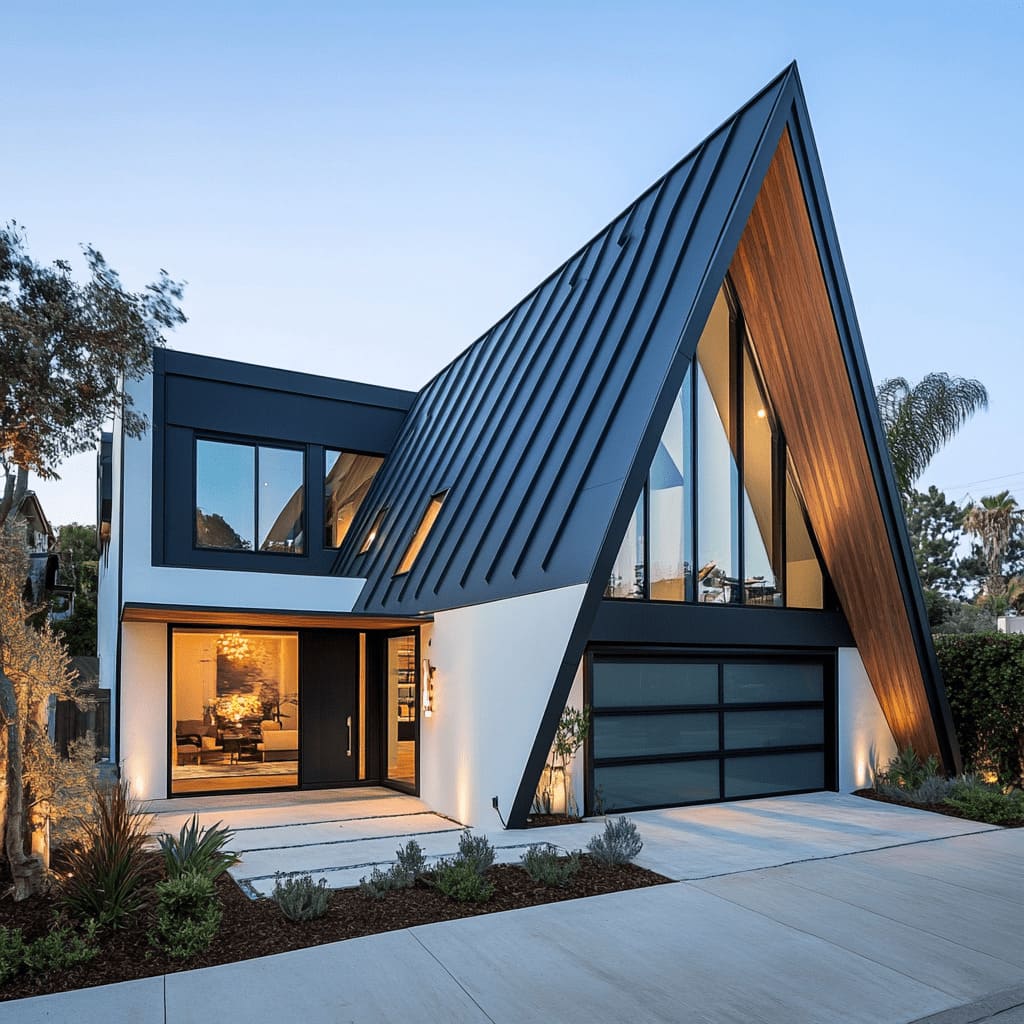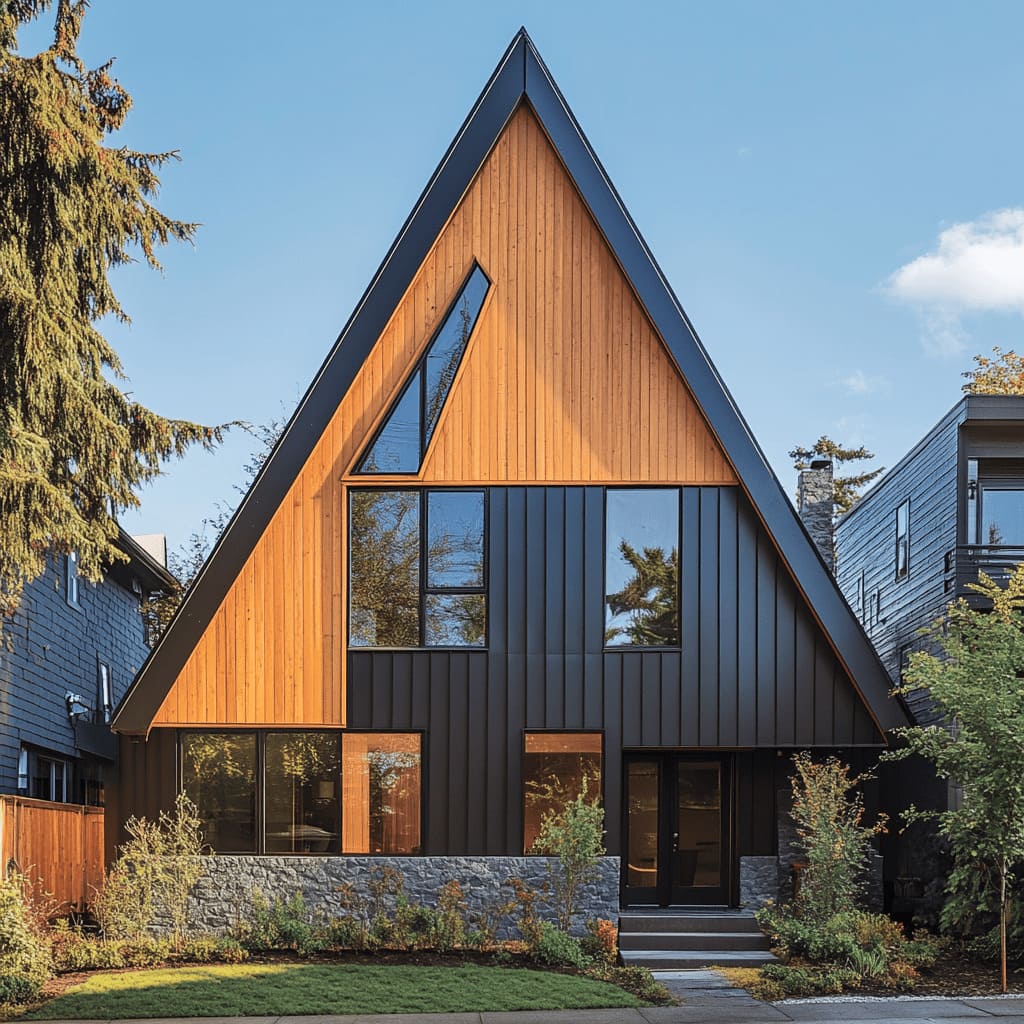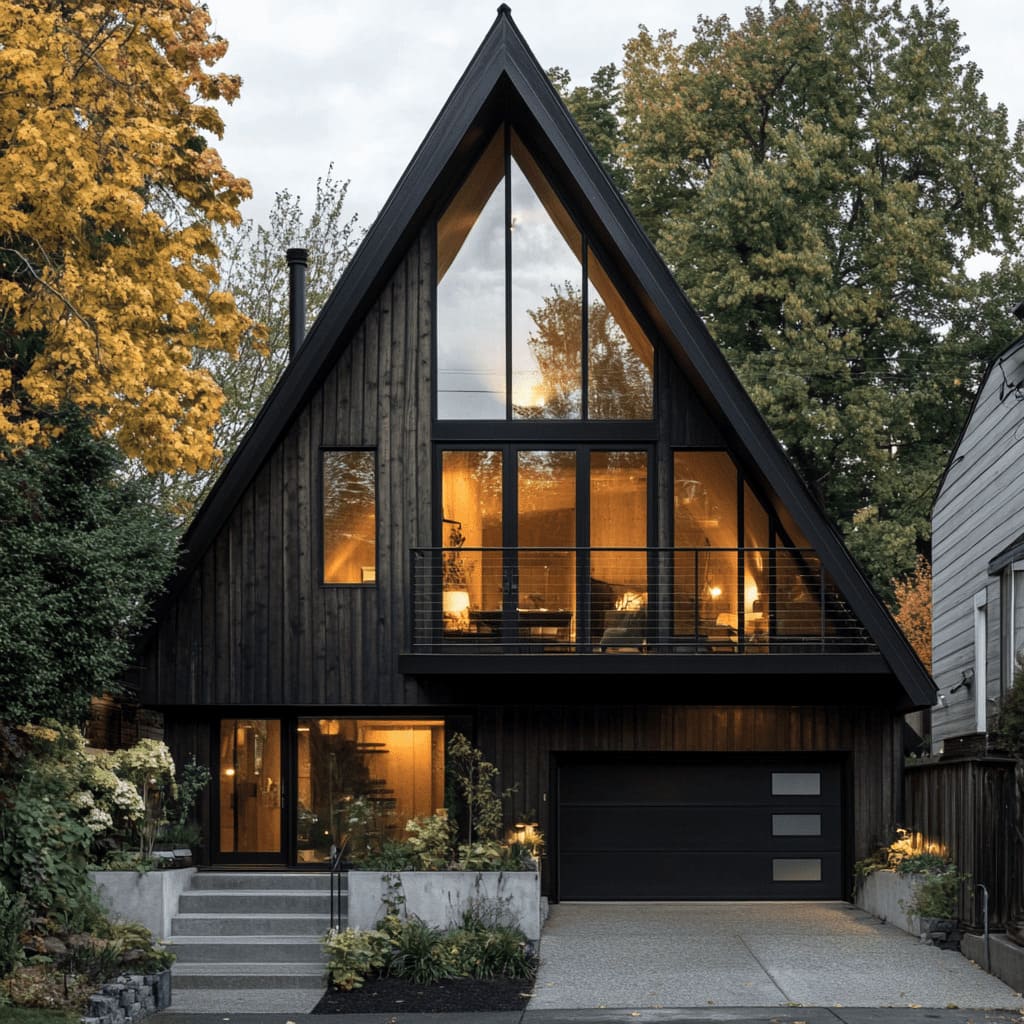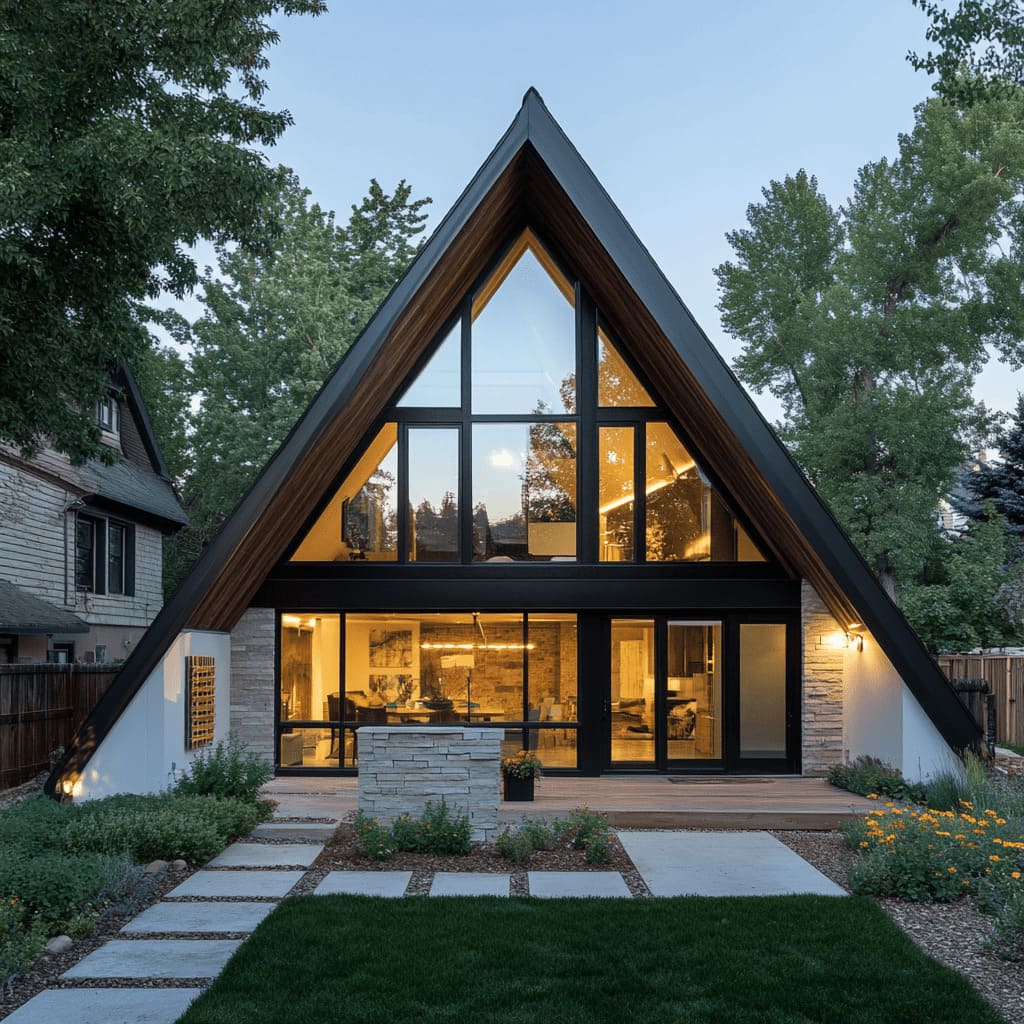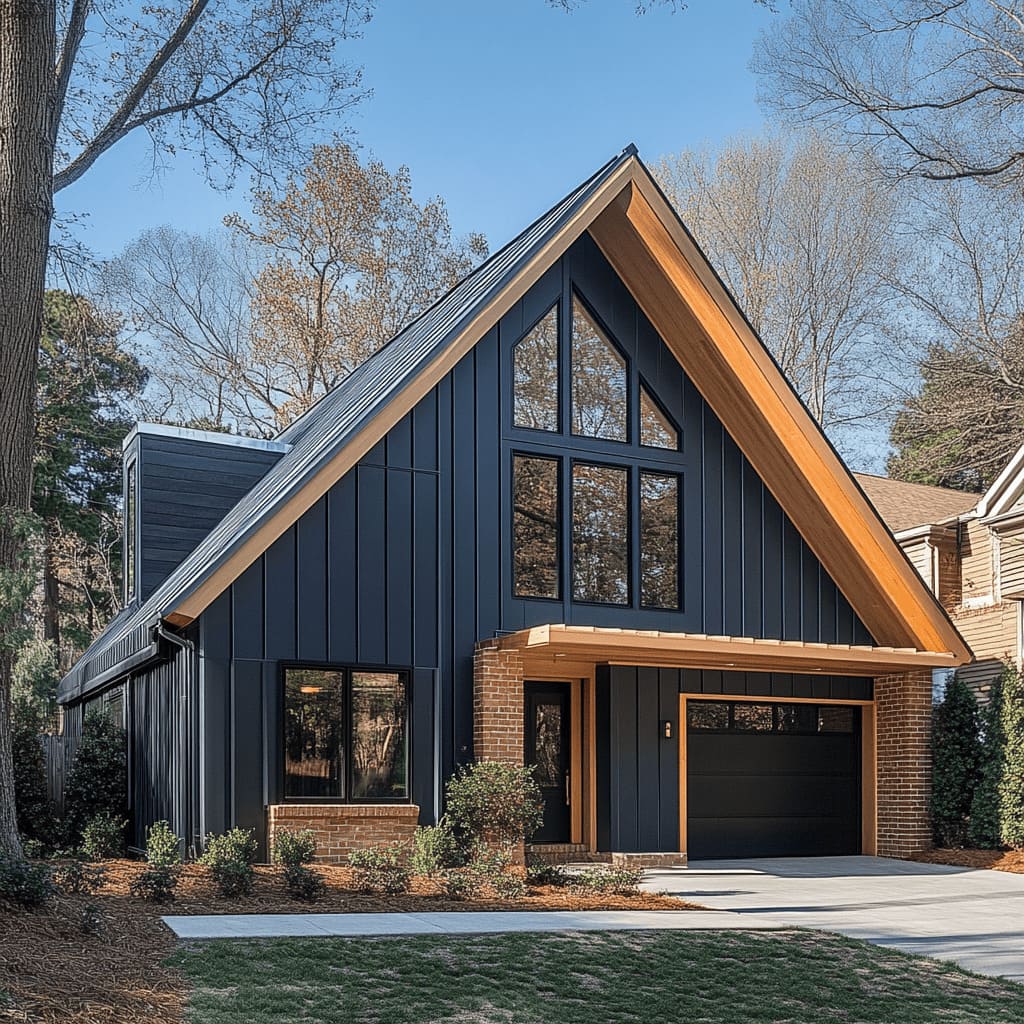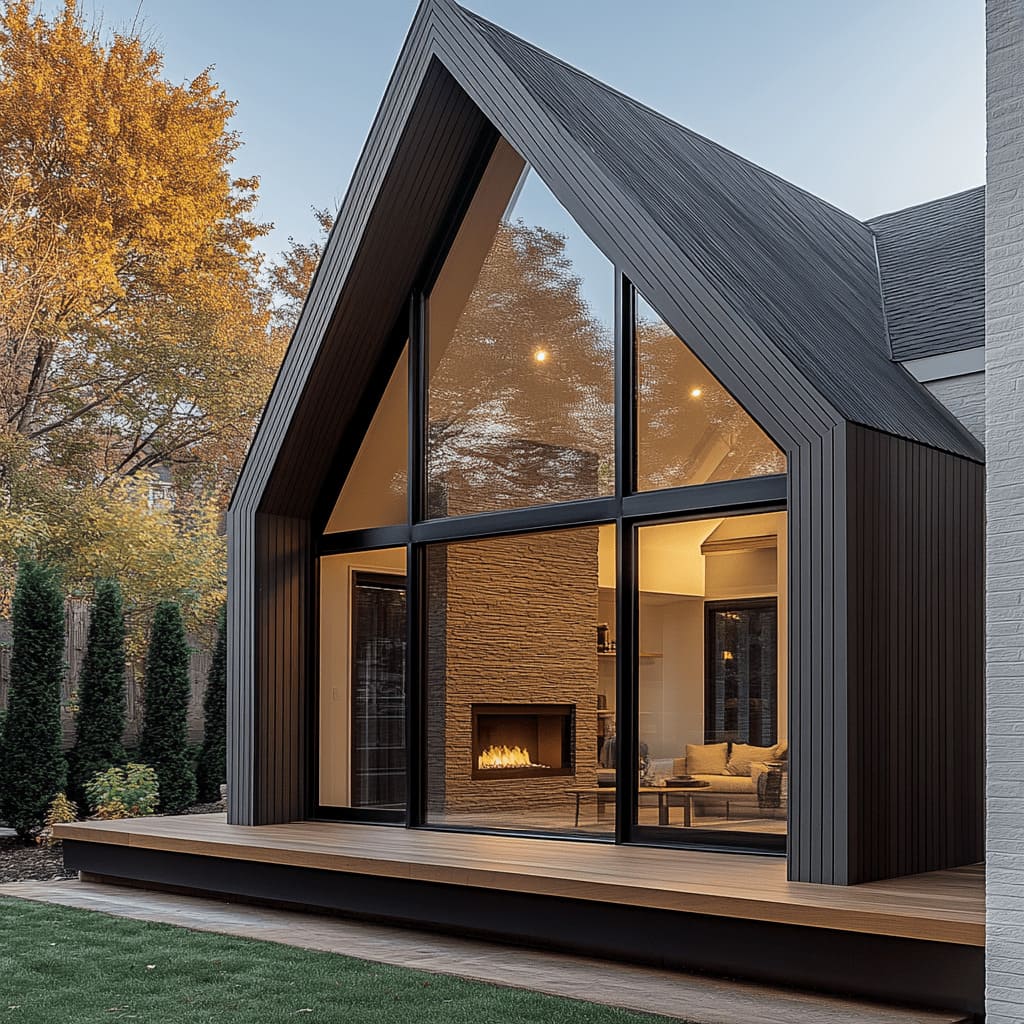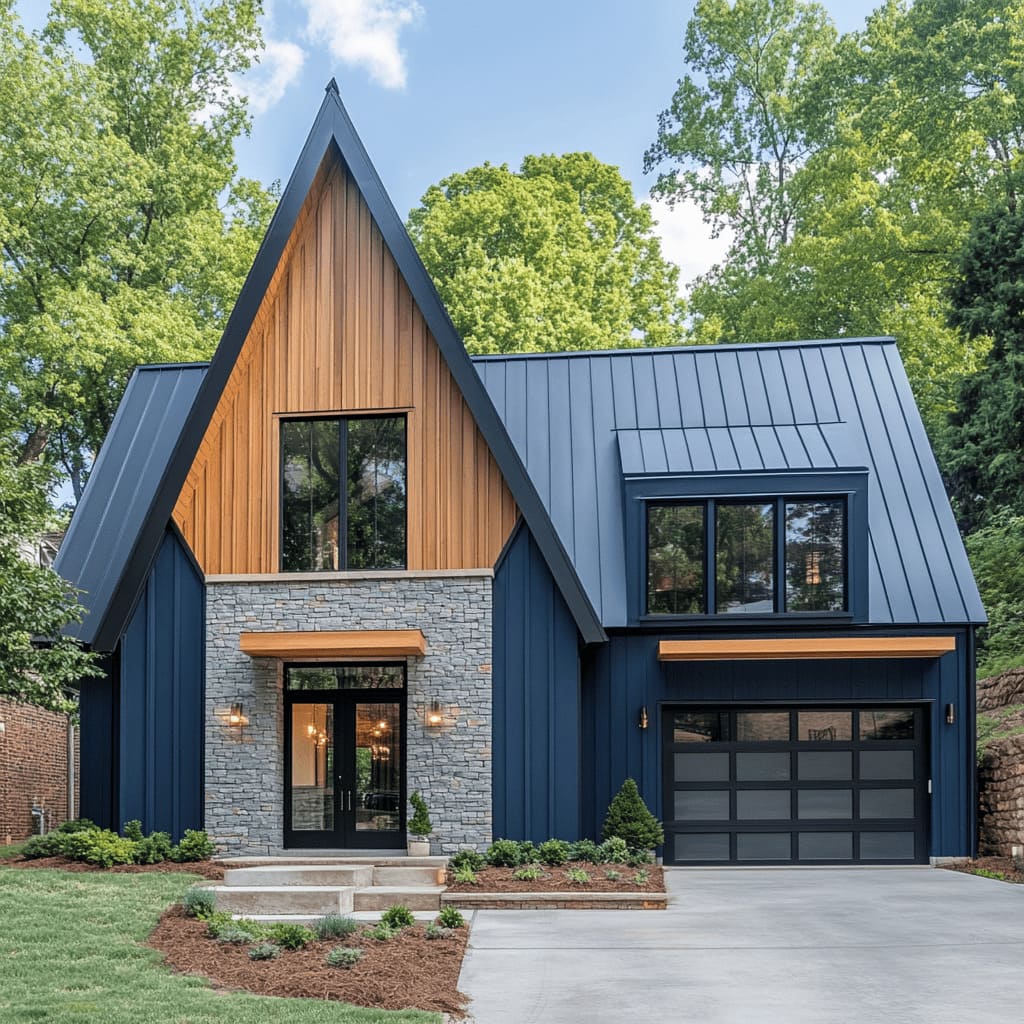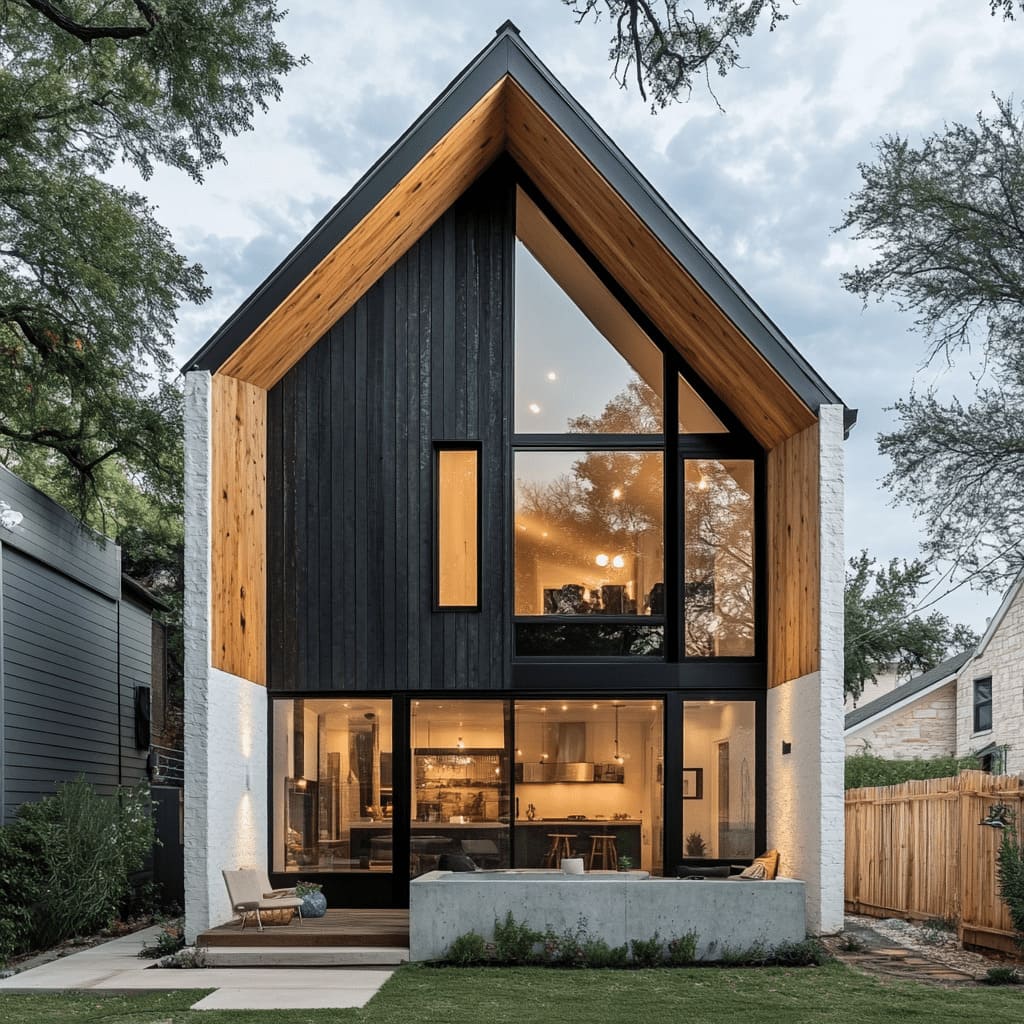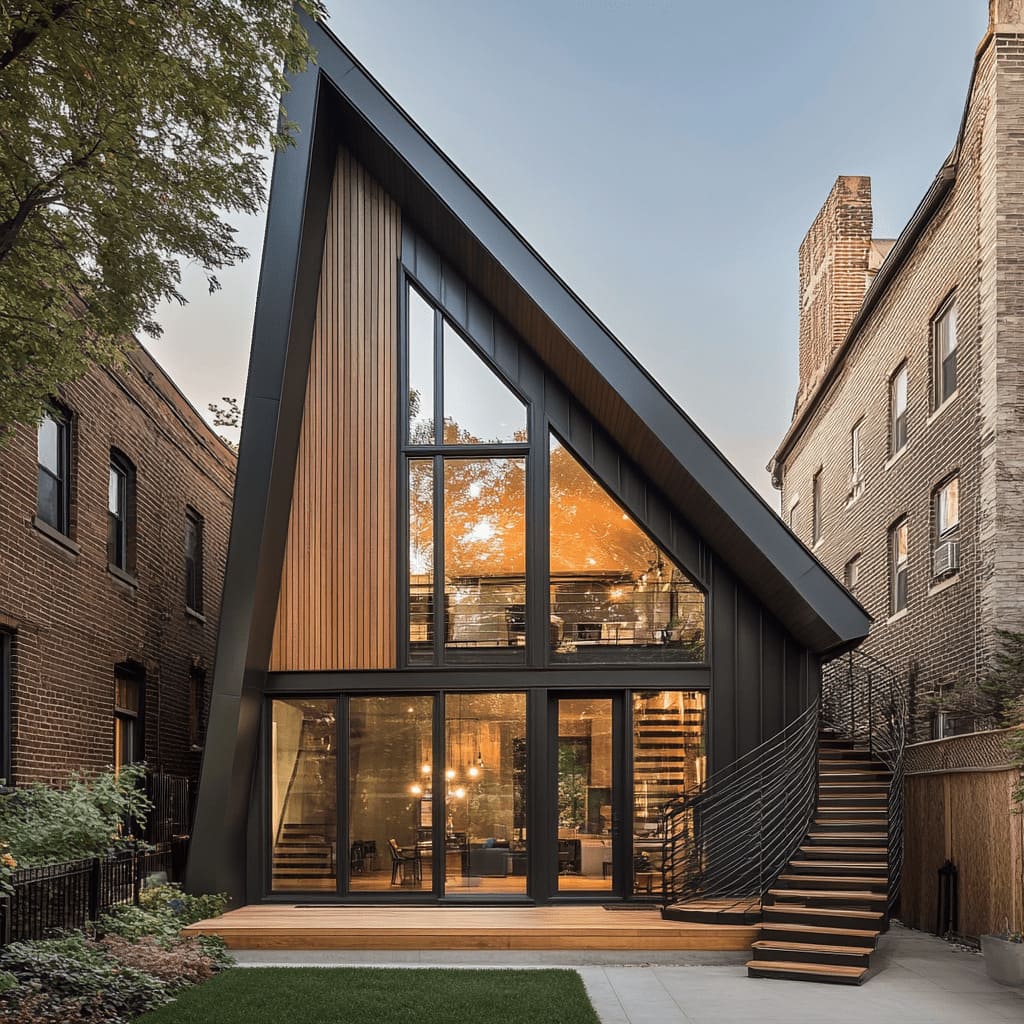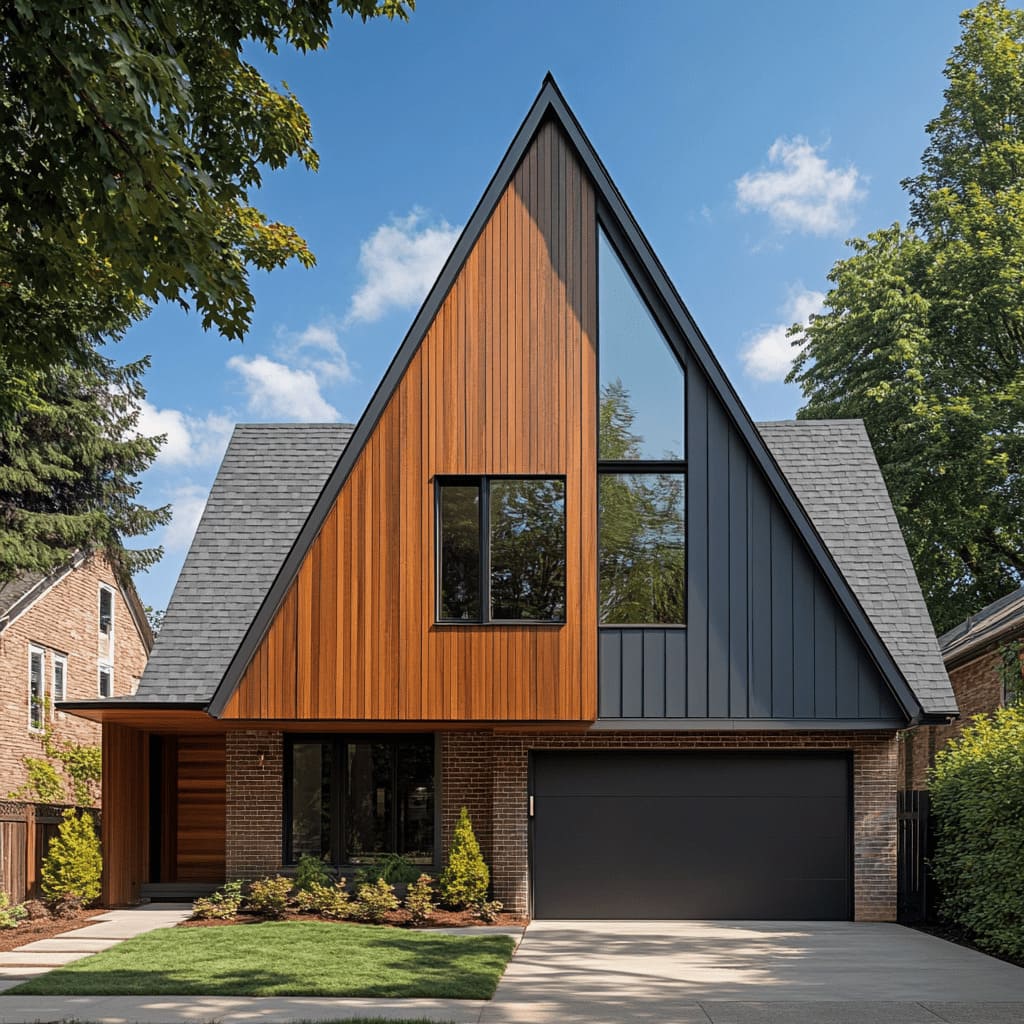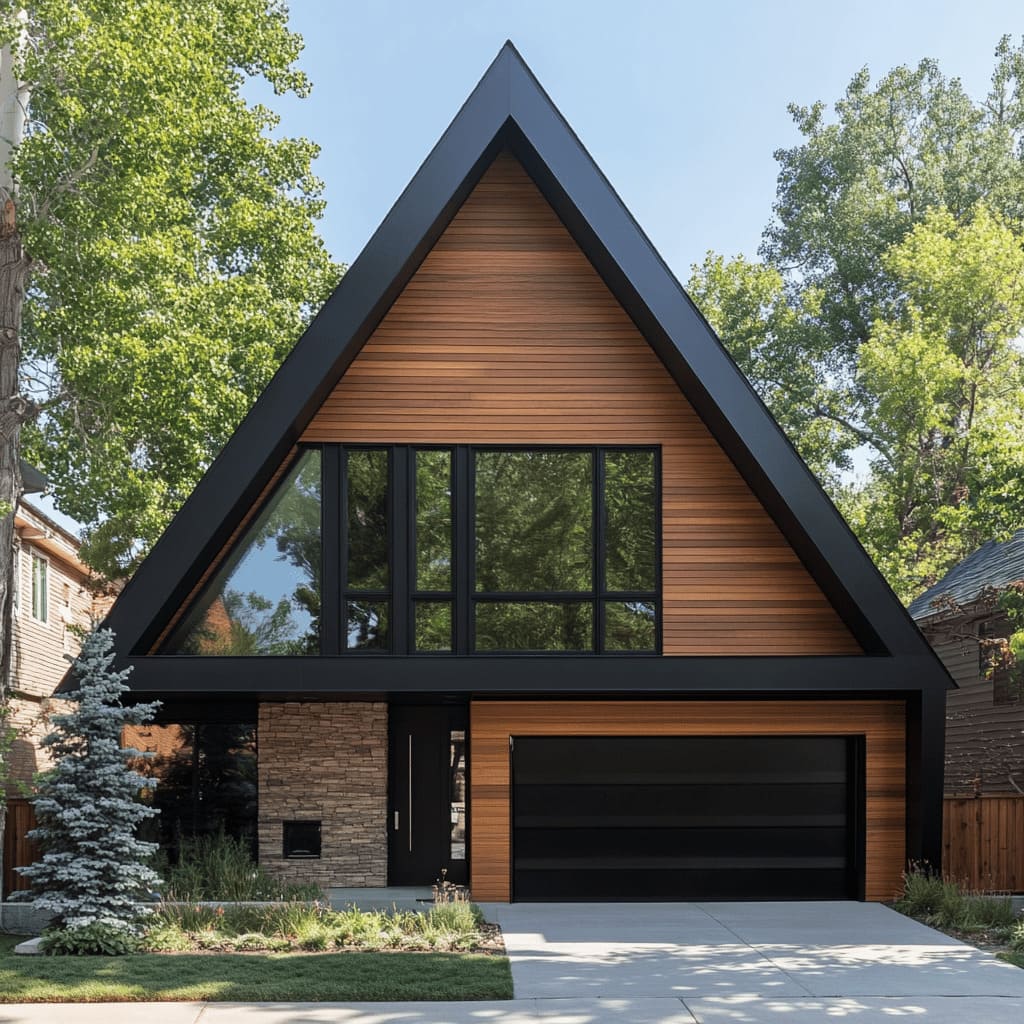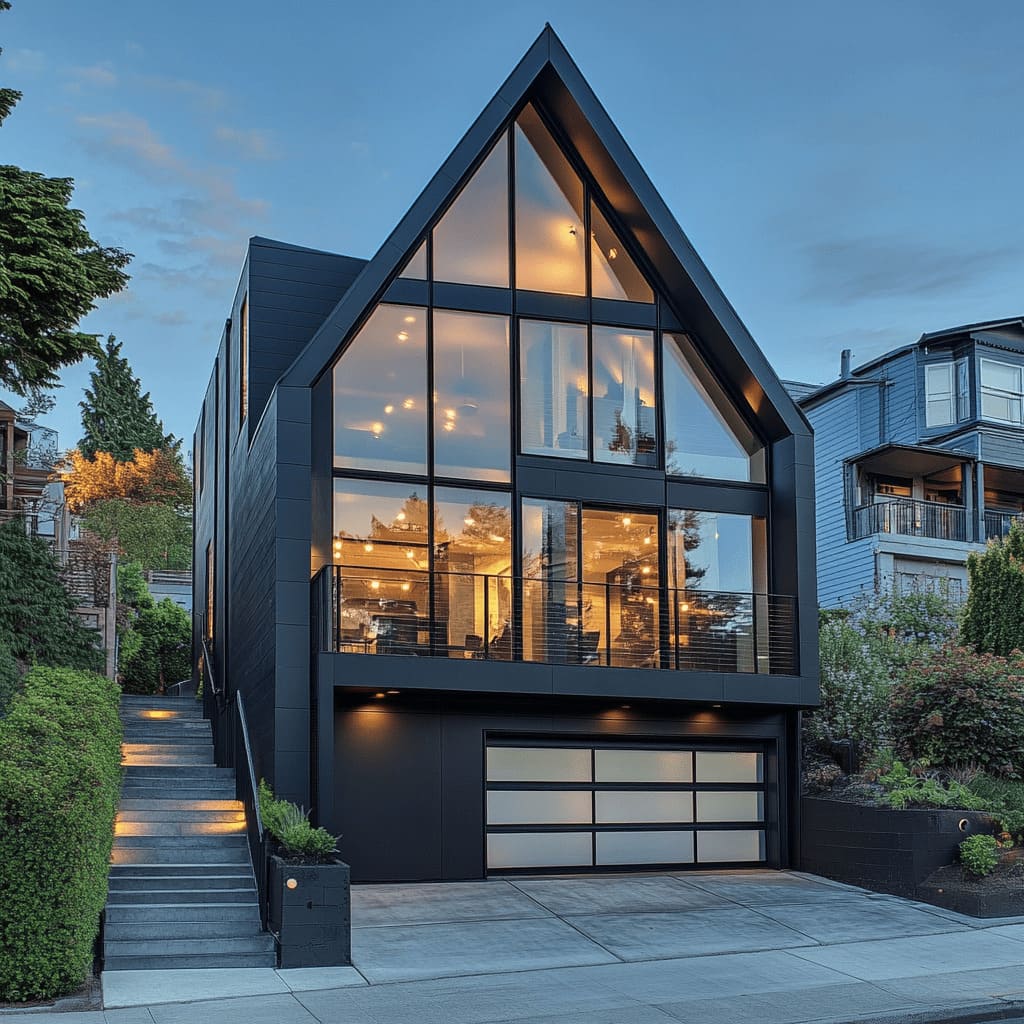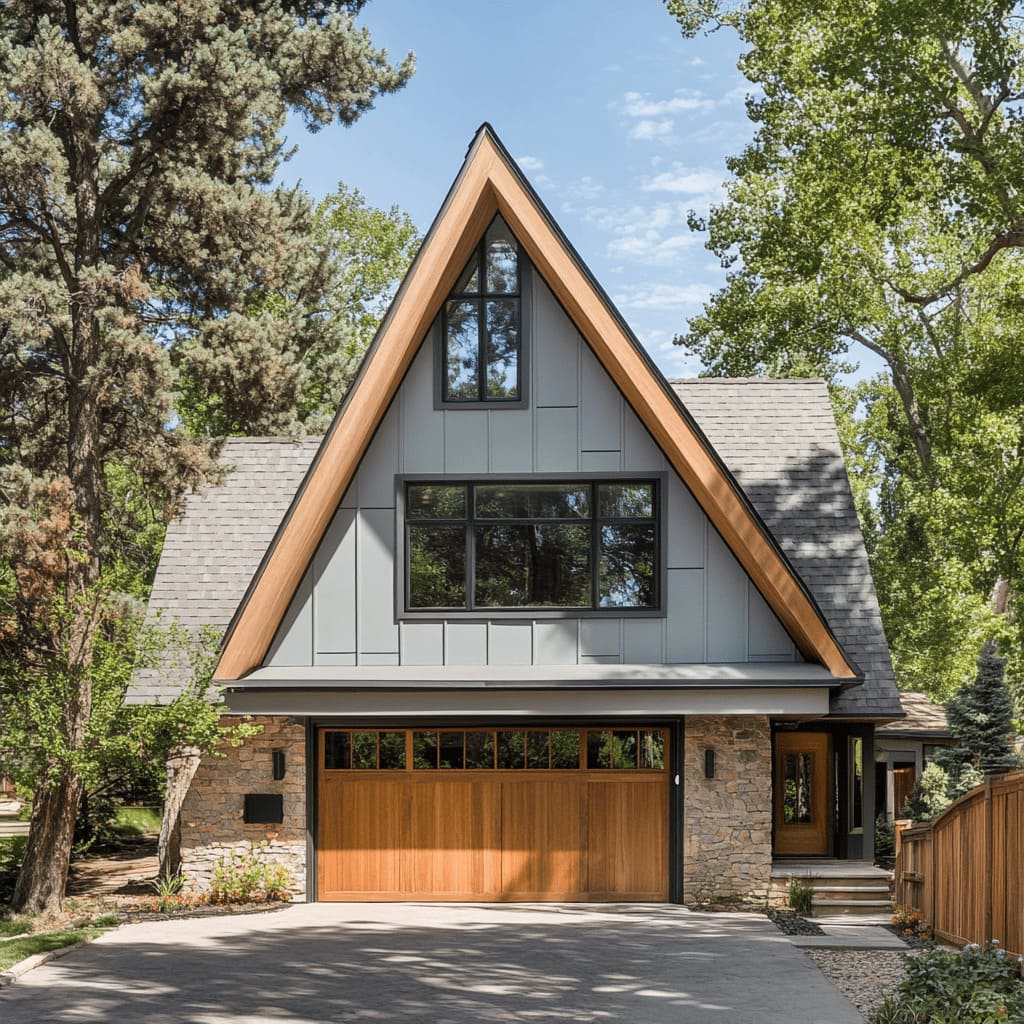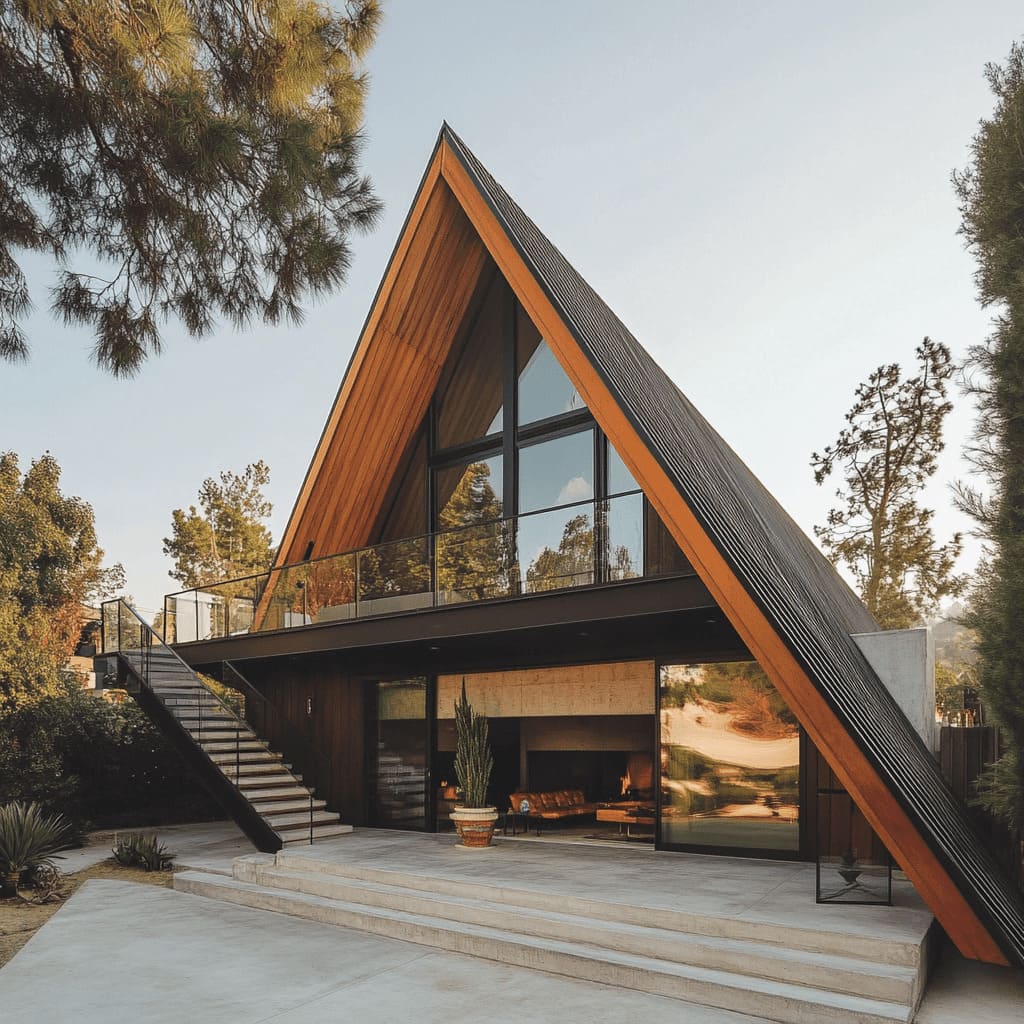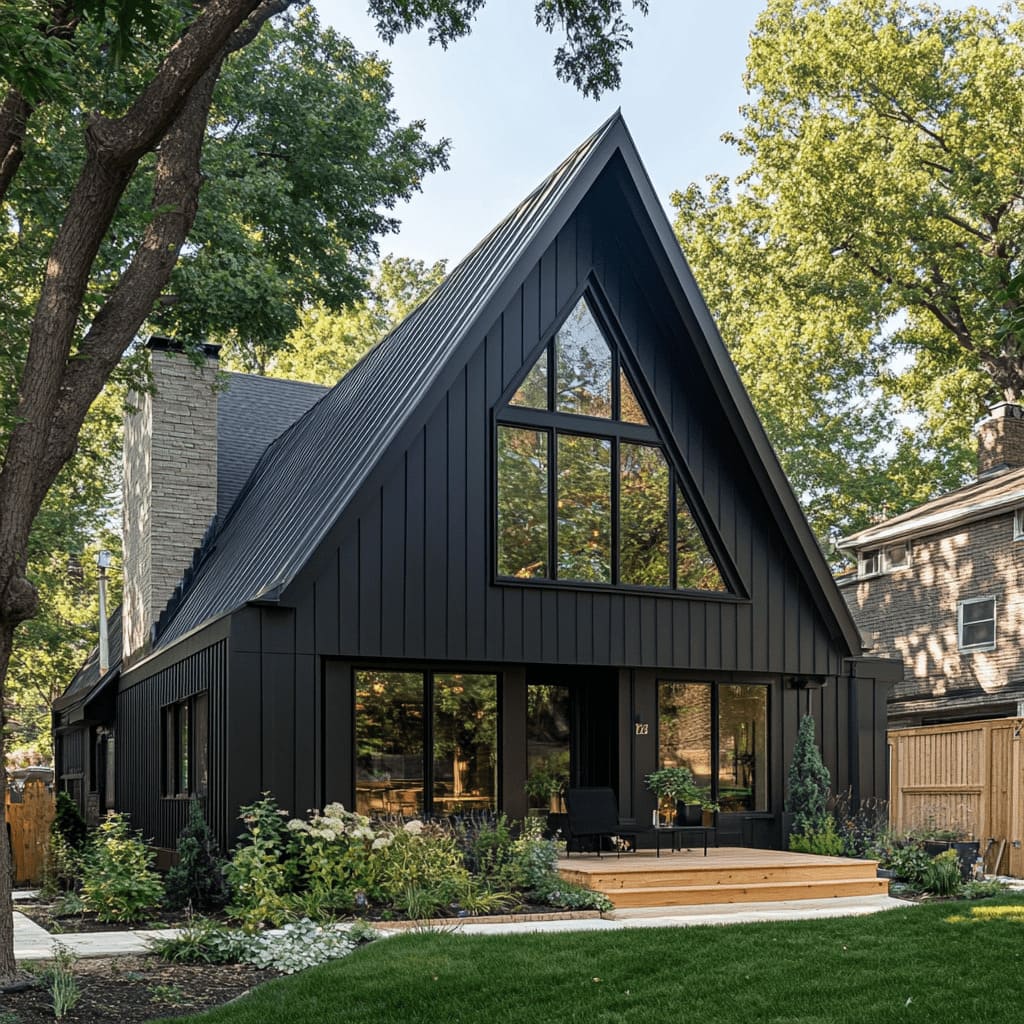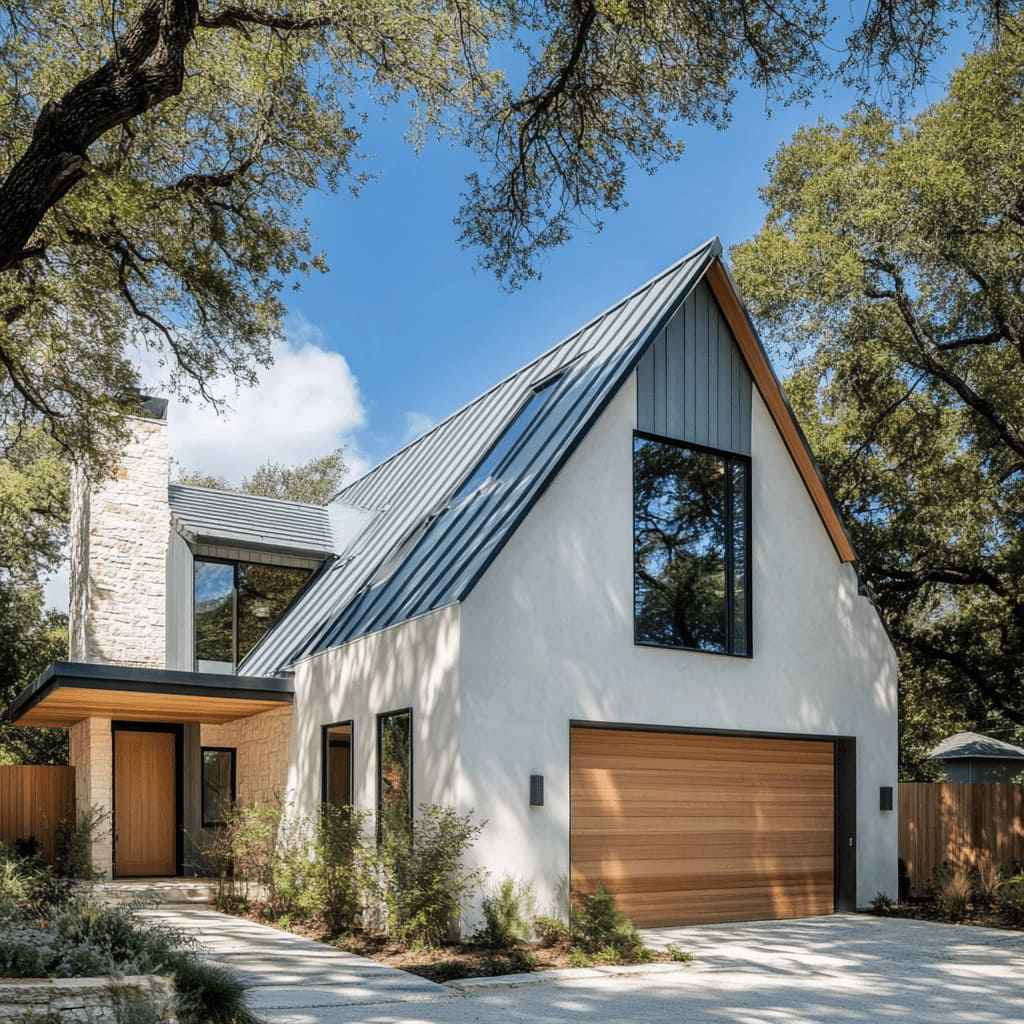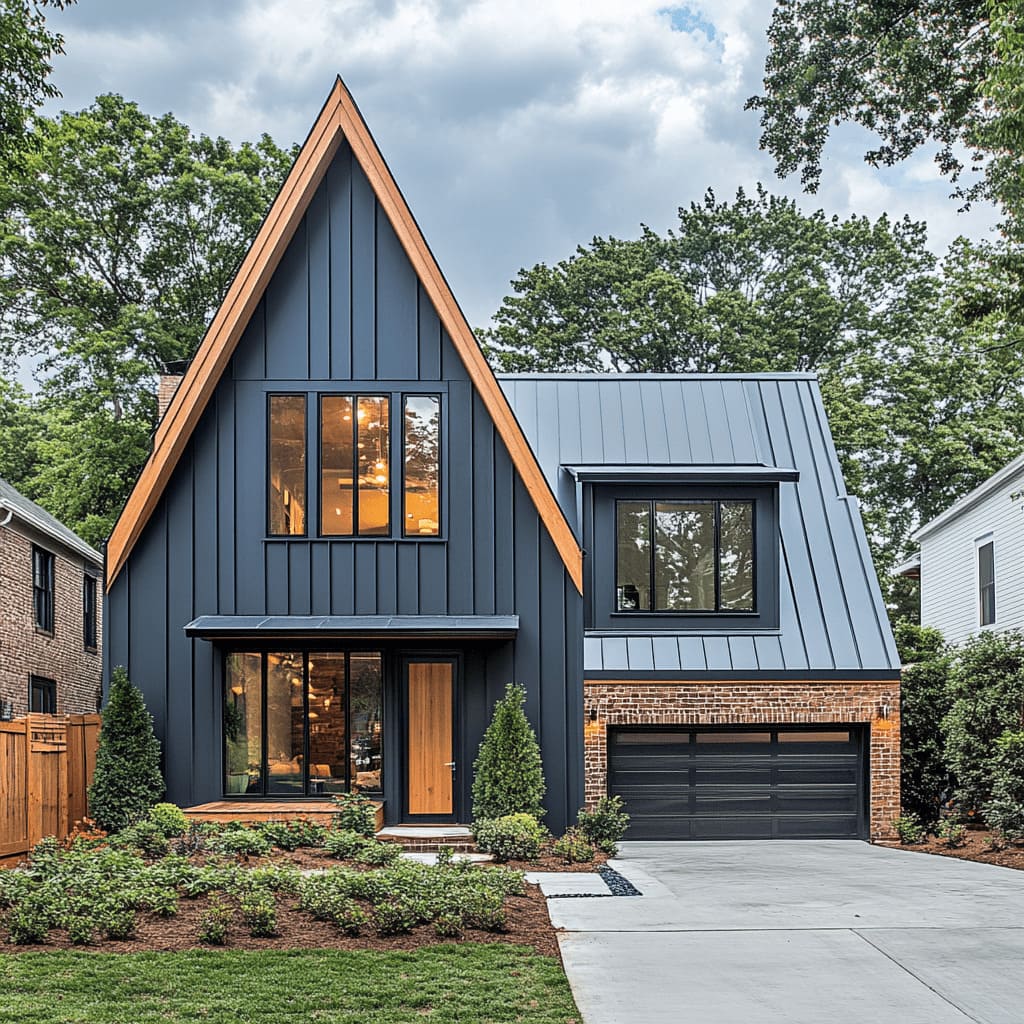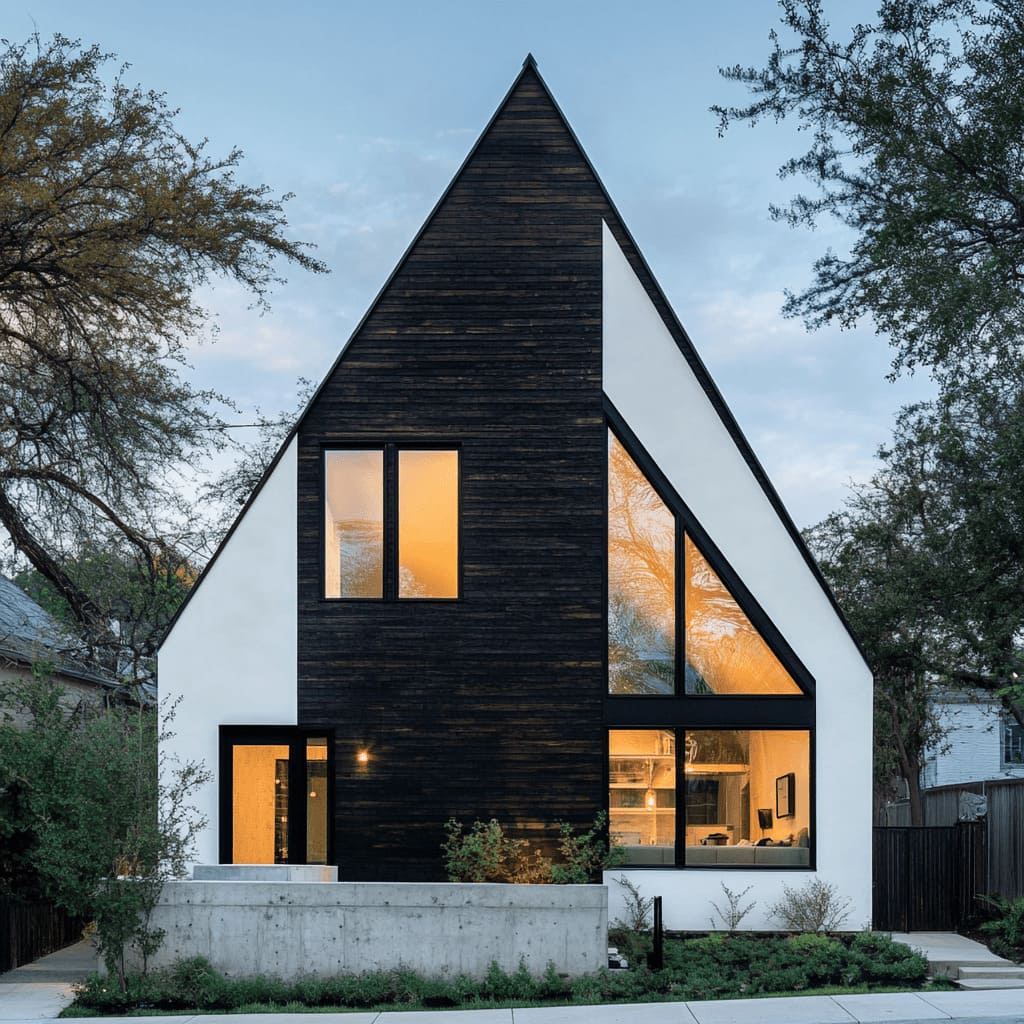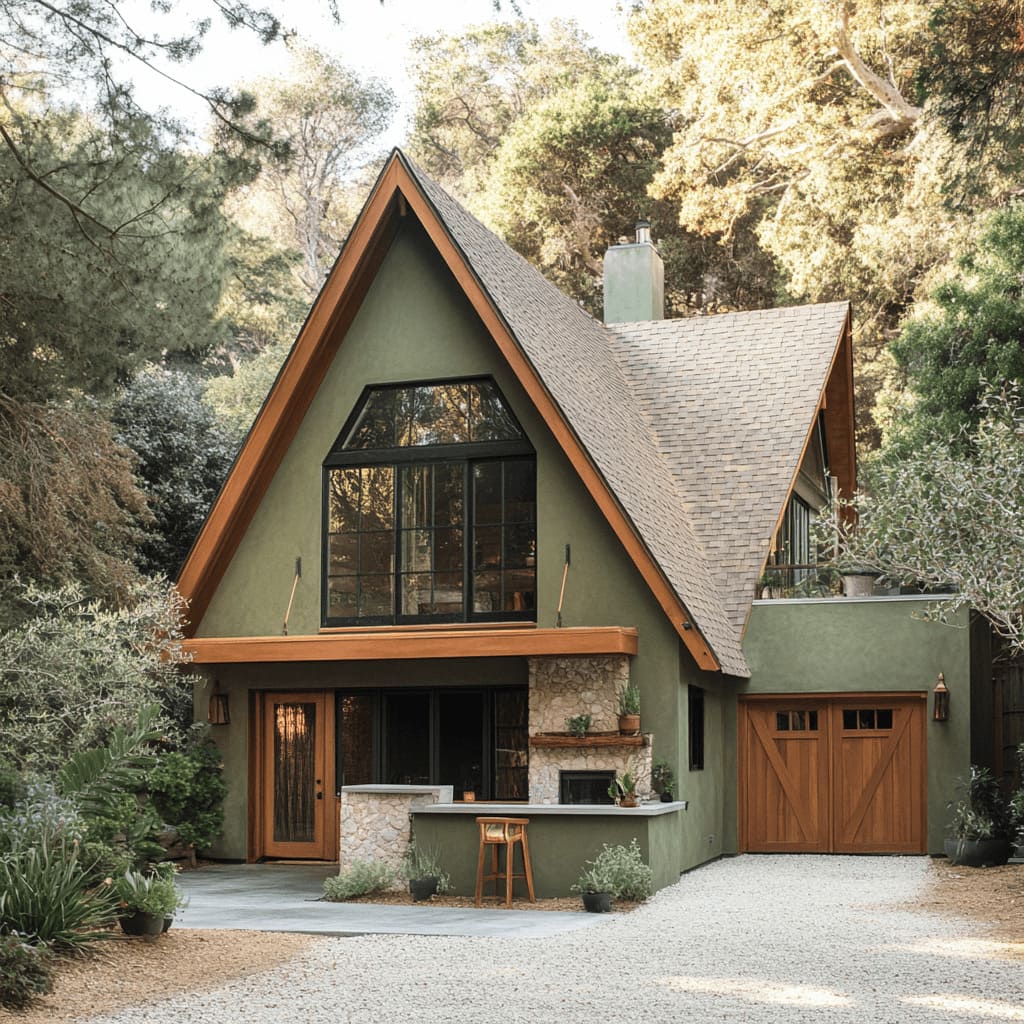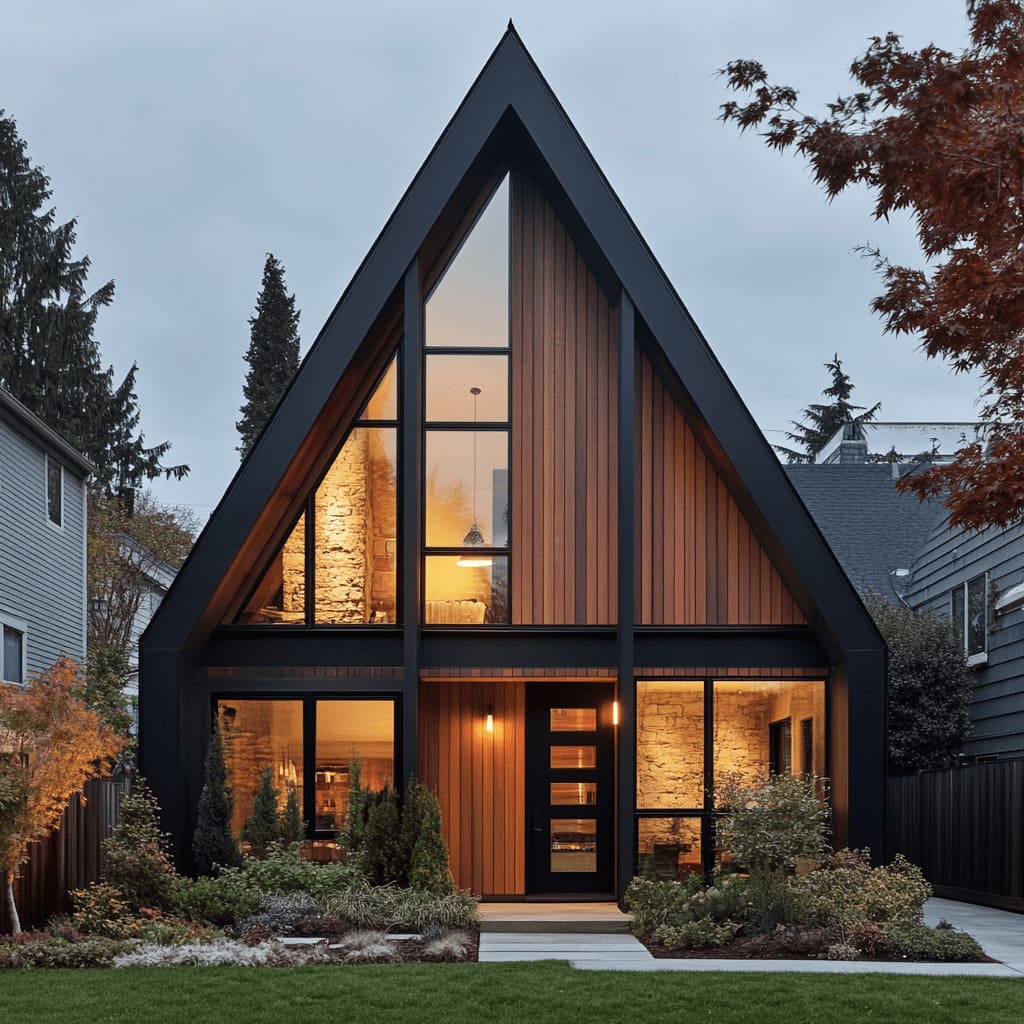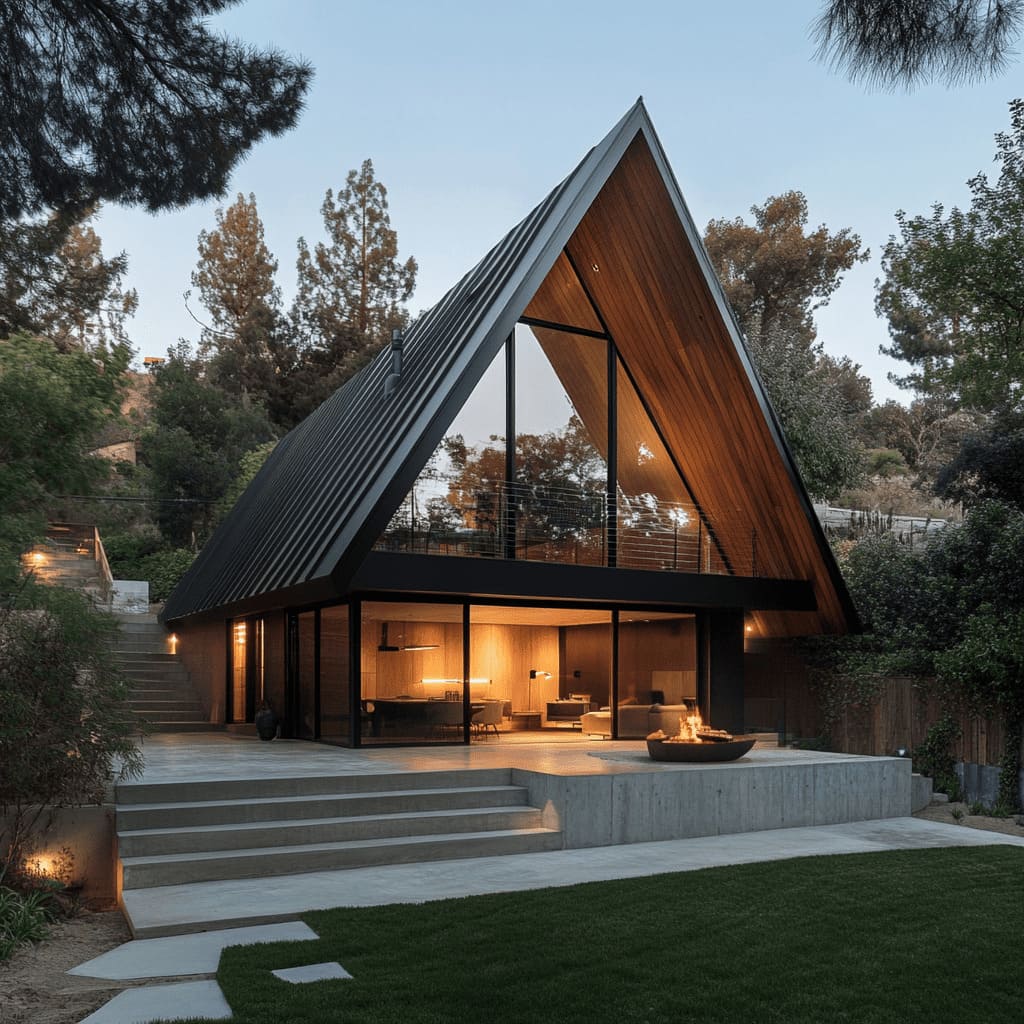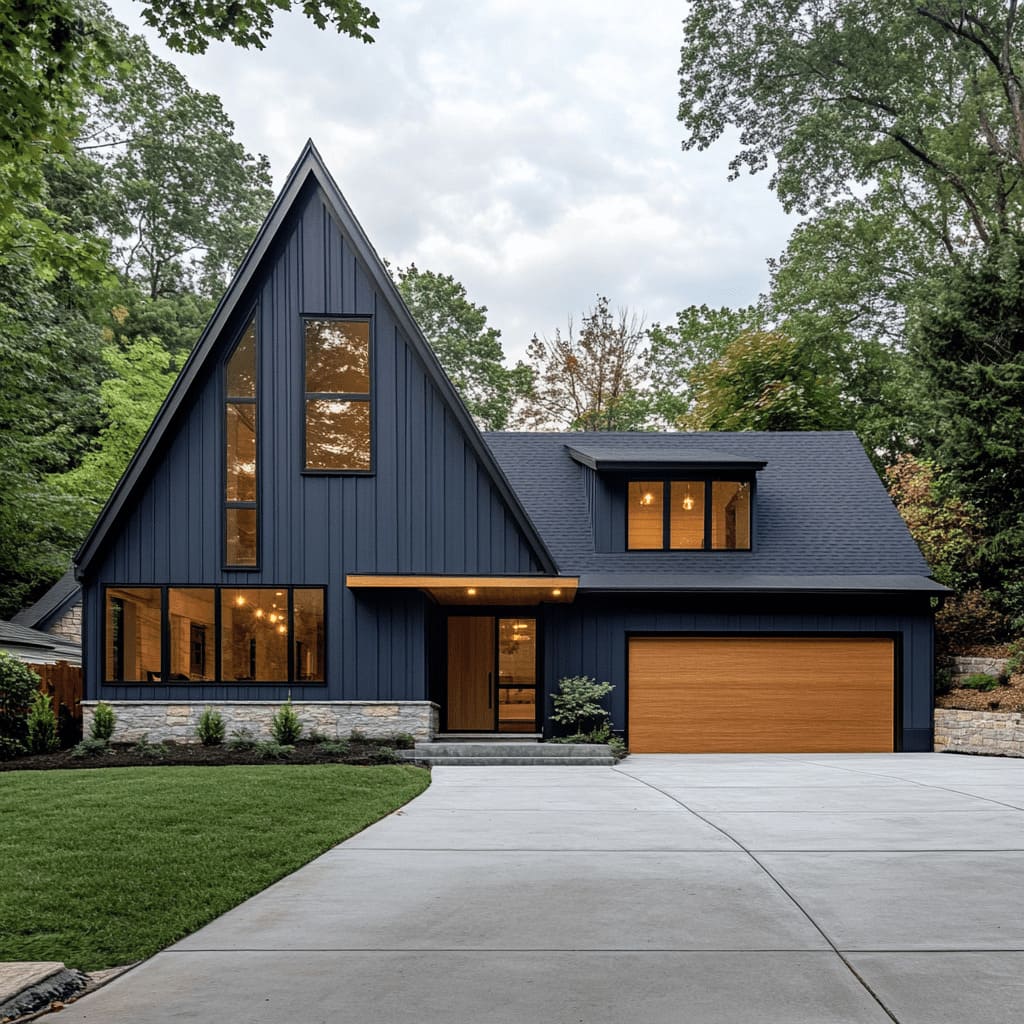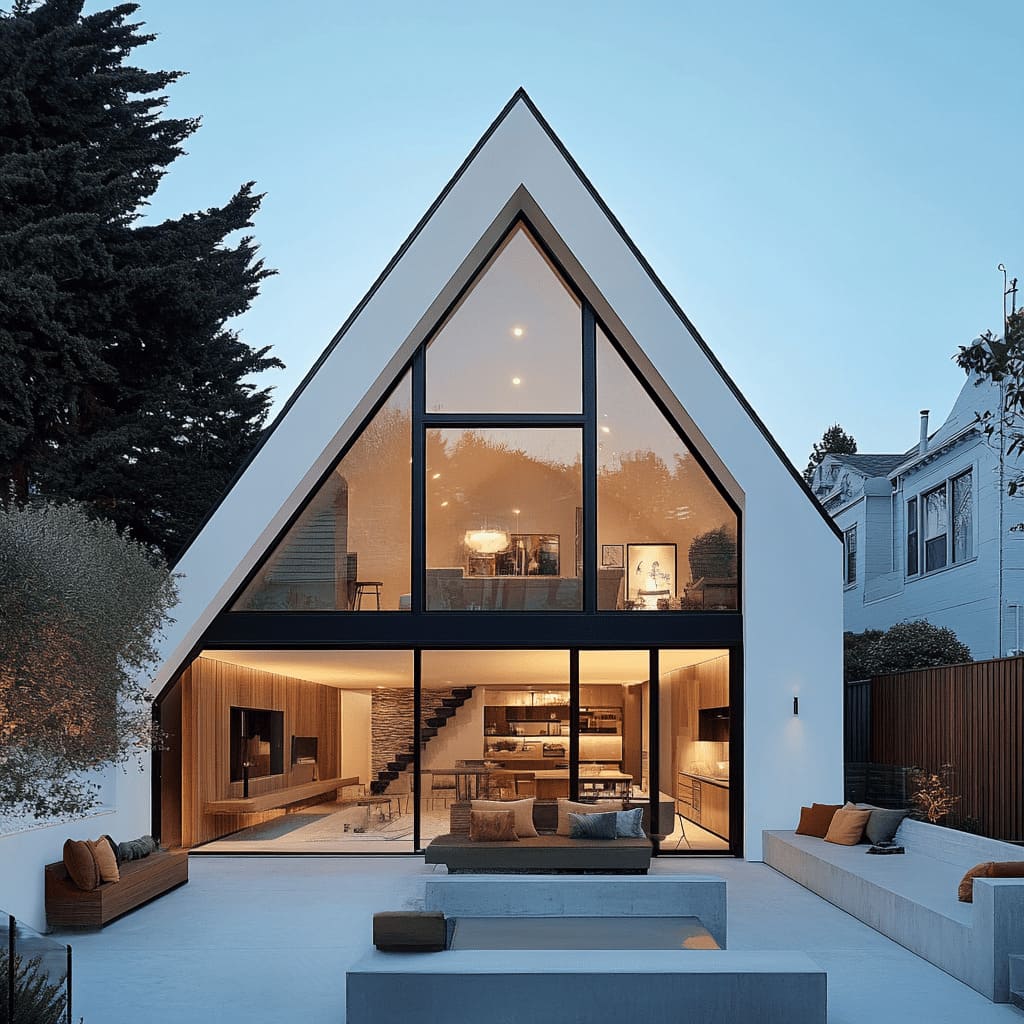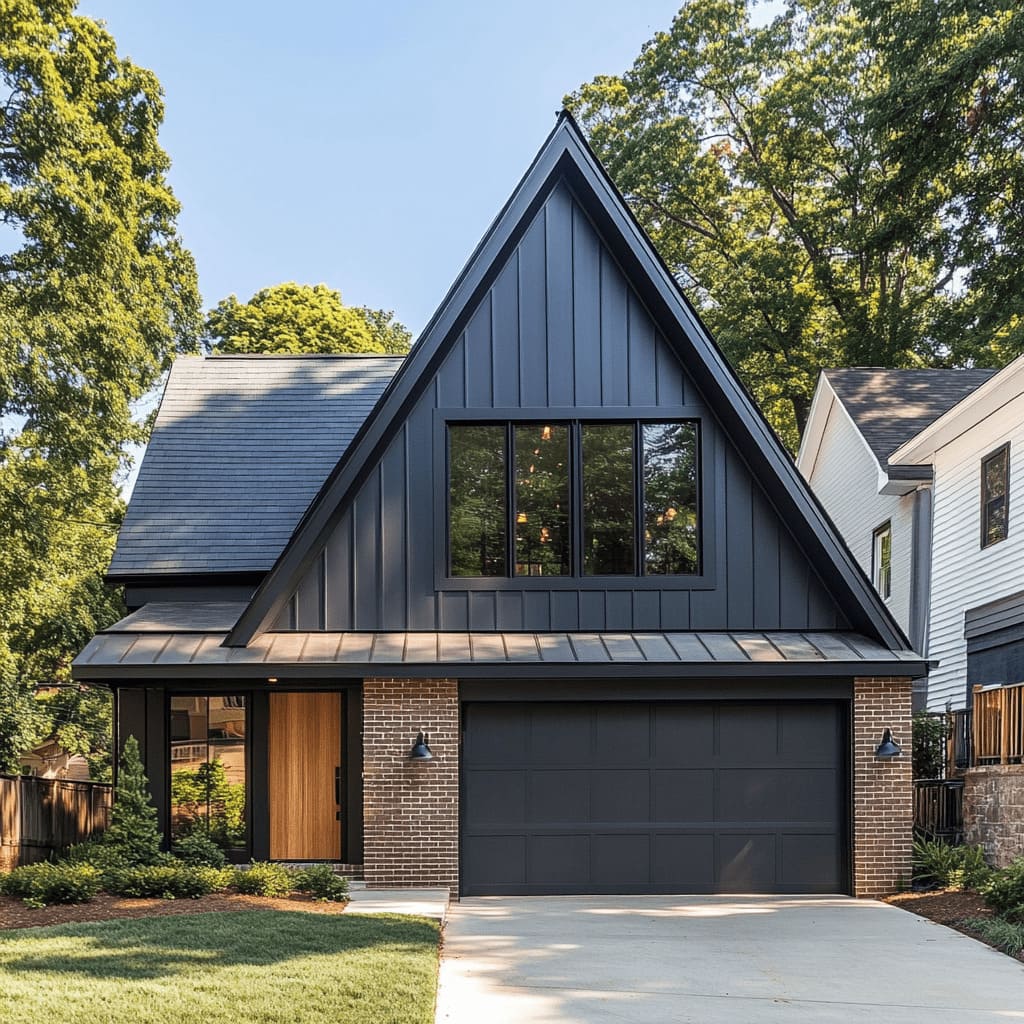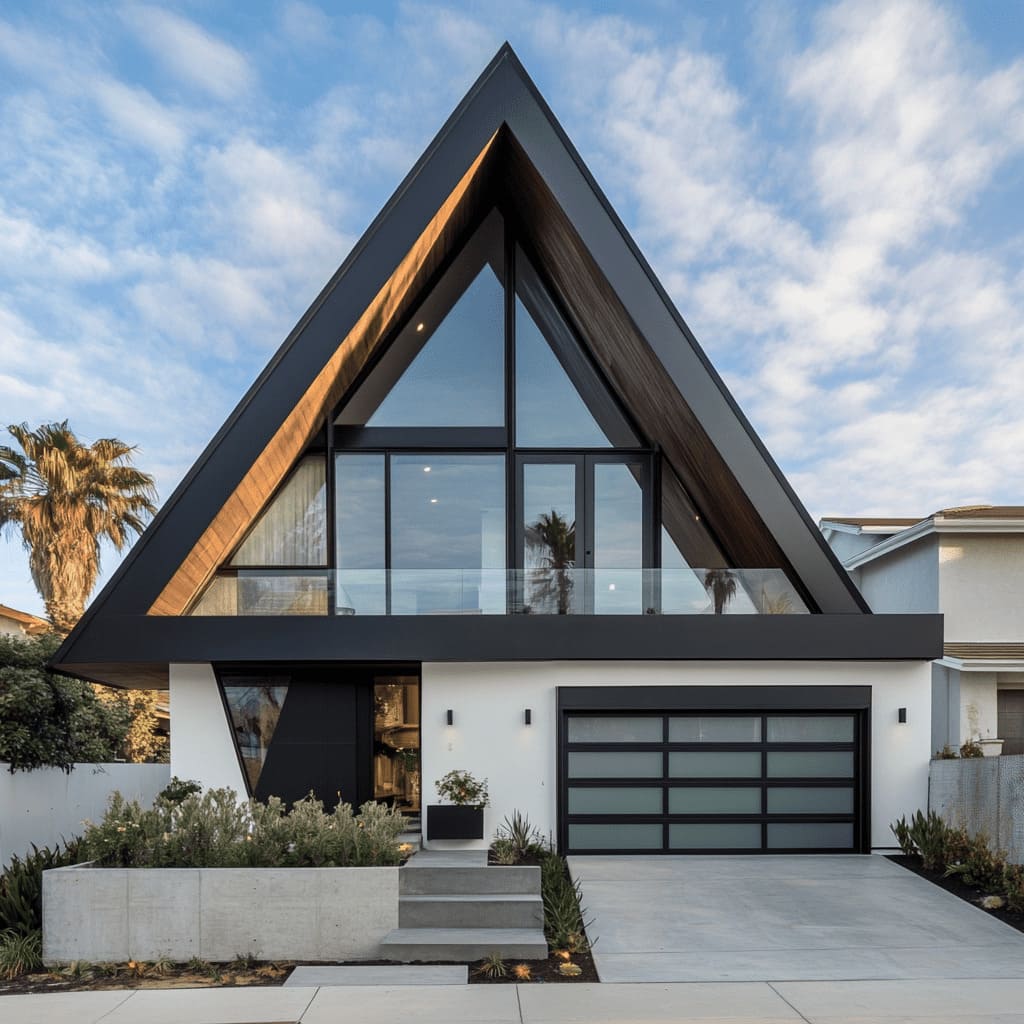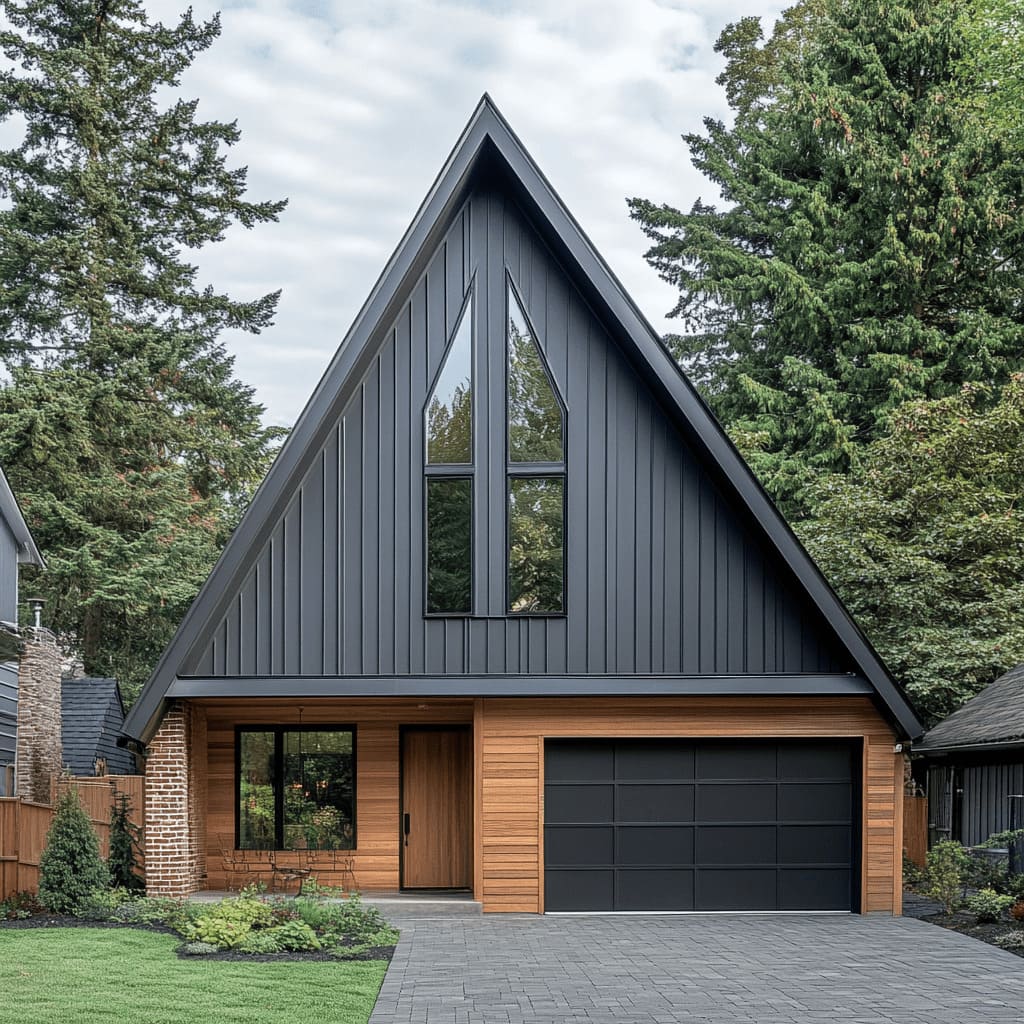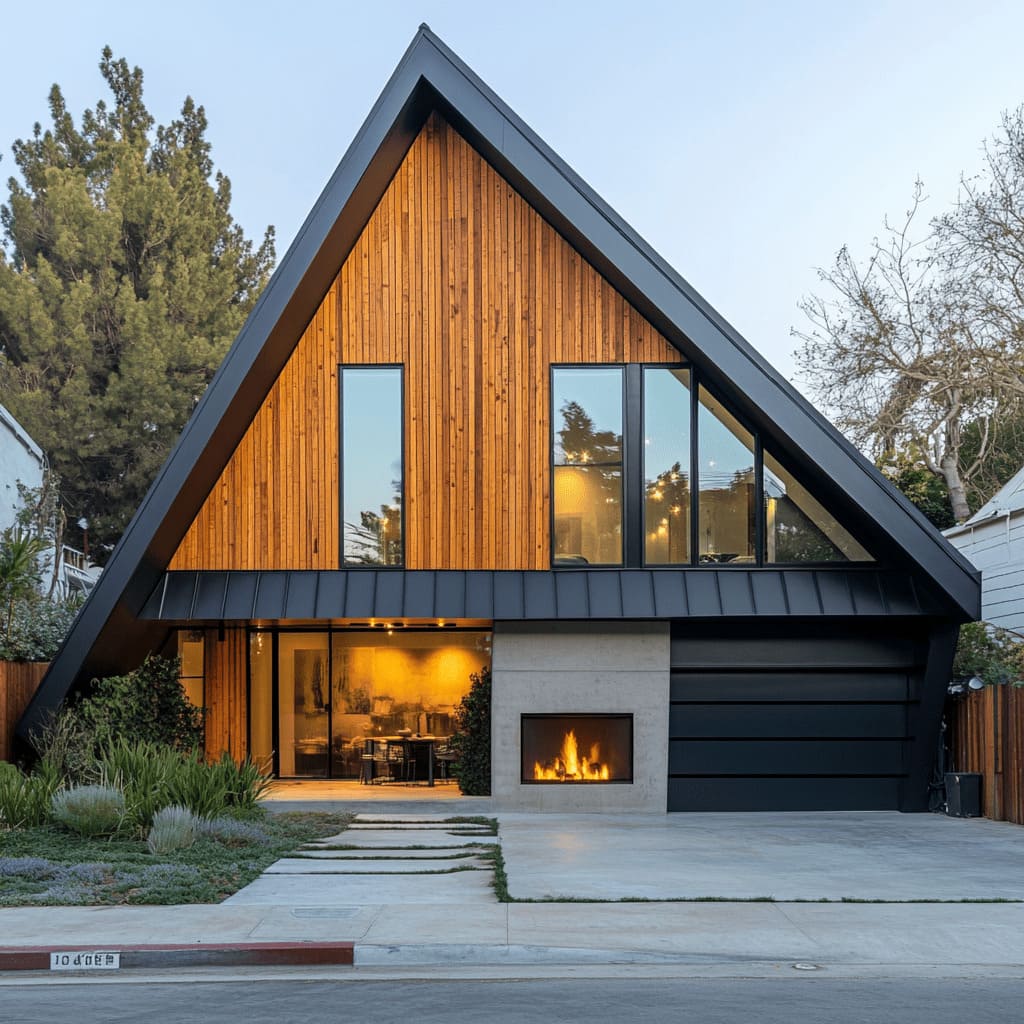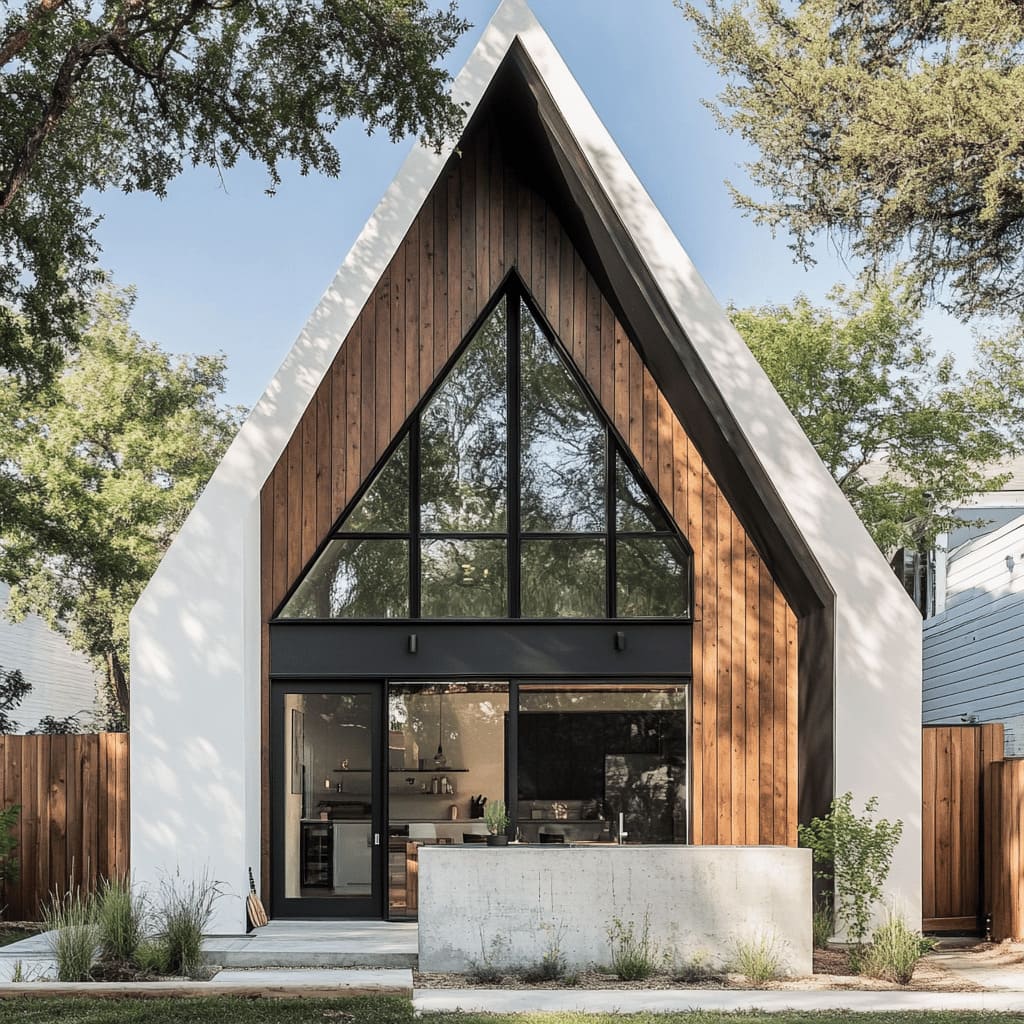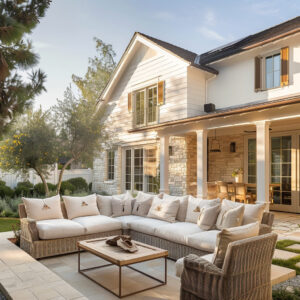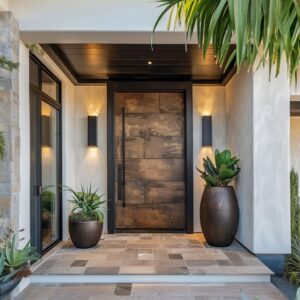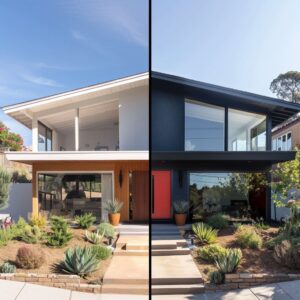A-frame homes, with their distinct triangular silhouettes and steeply pitched roofs, are making a significant resurgence in contemporary architecture. Known for their unique aesthetic and practical advantages, these homes blend rustic charm with modern minimalism.
In today’s world, where sustainable living and a strong connection to nature are increasingly valued, A-frame homes offer a perfect blend of style, functionality, and environmental harmony. This article explores why A-frame homes are becoming a popular choice for modern living and highlights their top features and benefits
The Architectural Appeal of A-Frame Homes
A Distinctive Shape and Silhouette
A-frame homes are instantly recognizable by their sharp, triangular shape, which creates a striking presence in any setting. The unique silhouette of an A-frame house offers a bold architectural statement that draws attention and captures the imagination.
This distinct form isn’t just about looks; it also brings several practical advantages that have contributed to the A-frame’s lasting popularity. The steep, angular roofline is one of the most defining features of A-frame homes.
This sharply pitched roof, often extending down to the foundation, naturally facilitates the easy shedding of rain, snow, and debris, reducing the risk of buildup that can lead to structural damage. In areas prone to heavy snowfall, this design is especially beneficial, preventing snow from accumulating and creating excessive weight on the roof.
The shape also helps to withstand strong winds, making A-frame homes a solid choice in regions with varied weather conditions
Beyond practical concerns, the steep roofline and triangular form create a feeling of height and openness inside the home. This maximizes vertical space, allowing for high ceilings and often a lofted second floor, which adds to the sense of spaciousness.
The dramatic angles draw the eye upwards, giving even compact homes a feeling of grandeur. These design elements offer endless possibilities for a frame house design ideas that play with height and volume, creating dynamic, open interiors
A Modern Take on a Classic Design
While A-frame homes have their roots in rustic cabin designs, contemporary A-frame houses have evolved significantly to incorporate modern elements that make them suitable for a range of environments, from forested retreats to urban lots. Today’s A-frame homes blend the charm of their classic form with sleek, modern materials and innovative features
One of the most prominent updates in modern A-frame house ideas is the use of expansive glazing. Large windows, often spanning the front or sides of the home, allow natural light to flood into the living spaces, creating bright, airy interiors that connect visually with the outdoors.
This open, light-filled atmosphere contrasts beautifully with the more closed, compact interiors of traditional A-frame cabins. The extensive use of glass also frames views of the surrounding landscape, whether it’s a forest, mountain, or cityscape, making the most of a home’s setting
Sleek metal finishes have become a popular choice for contemporary A-frame homes, replacing or complementing traditional wood siding. These materials not only enhance the home’s durability but also add a clean, modern edge that aligns with current architectural trends.
Combined with minimalist interior designs, which favor open floor plans, simple lines, and a neutral color palette, these updates give A-frame homes a fresh, sophisticated appeal. This fusion of old and new offers a range of a frame house ideas that cater to diverse tastes and preferences, from rustic simplicity to modern luxury
Key Features of A-Frame Homes for Modern Living
Steeply Pitched Roofs for Aesthetic and Functionality
The steep rooflines of A-frame homes are a defining characteristic that serves both aesthetic and functional purposes. Visually, the sharp angles create a bold profile that stands out against any backdrop, whether nestled among trees or set against an urban skyline.
Functionally, the steep pitch is highly effective in climates that experience heavy rain or snow, as it prevents accumulation and potential damage. This reduces maintenance needs and extends the lifespan of the home’s roofing materials
A variety of materials can be used for the roofs of A-frame homes, each offering its own benefits. Metal cladding, for instance, is a popular choice for its sleek appearance and durability.
Metal roofs are resistant to weathering and require minimal upkeep, making them ideal for a-frame addition ideas that aim to enhance the home’s resilience and modern aesthetic. Alternatively, traditional shingles can offer a more classic look while providing excellent protection against the elements.
The choice of roofing materials can greatly impact the overall aesthetic of the home, as well as its maintenance requirements, making it an important consideration in the design process
Expansive Windows and Natural Light
Modern A-frame homes often feature large, strategically placed windows that take full advantage of natural light. The extensive use of glass not only brightens the interior but also creates a seamless connection with the outdoors.
These windows often span from floor to ceiling, framing breathtaking views and making the surrounding landscape a central part of the living experience
This emphasis on natural light has several benefits. It reduces the need for artificial lighting during the day, which can lower energy costs and contribute to a more sustainable living environment.
Additionally, ample natural light can enhance mood and well-being, making the home a pleasant place to live. The large windows also provide opportunities for passive solar heating, capturing sunlight in the colder months and helping to keep interiors warm.
This combination of aesthetics and energy efficiency makes expansive windows a key feature in any a-frame house design ideas
Use of Natural Materials
A-frame homes have a strong tradition of using natural materials, such as wood and stone, both inside and out. These materials add a sense of warmth and texture to the design, creating a cozy, inviting atmosphere that feels grounded and connected to nature.
Wood, in particular, is a staple of A-frame construction, often used for everything from exterior siding to interior beams and floors
Stone is another material frequently incorporated into A-frame designs, especially in foundations, chimneys, and accent walls. Stone provides a natural, rugged texture that contrasts beautifully with the sleek lines and smooth surfaces of modern finishes.
These natural materials are not only aesthetically pleasing but also sustainable choices, as they are durable and have a lower environmental impact compared to synthetic alternatives. By emphasizing the use of natural materials, A-frame homes create a cozy, rustic charm that contrasts with the sleek, minimalist elements of contemporary design.
This balance of old and new gives the home a timeless appeal, blending comfort with sophistication
Integration with the Environment
One of the most compelling aspects of A-frame homes is their ability to blend seamlessly with their surroundings. The design’s steep angles and natural materials often mirror the verticality and textures found in nature, such as tall trees and rocky landscapes.
This integration with the environment enhances the home’s aesthetic appeal and promotes a sense of tranquility and harmony with the natural world
Landscaping plays a crucial role in this integration, with design strategies that use native plants, natural stone pathways, and outdoor living spaces to connect the home to its setting. Thoughtful landscaping can enhance privacy, create shade, and reduce the need for artificial heating and cooling.
In mountainous or forested areas, for example, A-frame homes can be positioned to take advantage of natural windbreaks or sun exposure, optimizing both comfort and energy efficiency. By carefully considering the site and surroundings, A-frame homes can be designed to complement the landscape rather than compete with it, creating a serene and sustainable living environment.
This harmony with nature is one of the defining characteristics that continue to make A-frame homes a popular choice for those seeking a unique and meaningful connection to their environment
Benefits of A-Frame Homes for Contemporary Lifestyles
Maximizing Space in a Compact Footprint
One of the standout benefits of the A-frame home design is its ability to maximize space within a compact footprint. The A-frame’s triangular shape inherently uses vertical space efficiently, making it ideal for both small lots and expansive landscapes.
The steep roofline, sloping down to the foundation, opens up possibilities for creative use of interior space that traditional rectangular homes might overlook
In an A-frame, the height created by the steeply pitched roof allows for loft areas, which can be used as additional bedrooms, cozy reading nooks, or even home offices. These loft spaces capitalize on the height of the structure without expanding the home’s footprint, offering a clever solution for those looking to maximize living space without encroaching on their outdoor environment.
The use of vertical space also supports open-plan living, where living, dining, and kitchen areas flow seamlessly into one another without the interruption of walls. This open layout not only makes the home feel larger but also encourages natural light to spread throughout the interior, enhancing the feeling of spaciousness
Storage solutions in A-frame homes are equally inventive, with built-in cabinetry, under-stair storage, and custom-designed closets that make use of every inch of available space. The triangular walls create unique opportunities for cabinetry and shelving, making the most of otherwise unused corners.
These creative storage options allow homeowners to keep their living areas uncluttered and streamlined, adding to the overall functionality of the space. For those looking for a frame home design ideas, the focus on vertical and compact living makes the A-frame an adaptable and efficient choice
Energy Efficiency and Sustainability
A-frame homes are naturally energy-efficient, thanks to their shape and the materials commonly used in their construction. The steep, sloped roof helps regulate the interior temperature by minimizing the amount of roof surface exposed to direct sunlight, which reduces heat absorption during the summer months.
In the winter, the angled roof helps snow slide off quickly, preventing excess weight and reducing the need for heating. This natural insulation is a key benefit of the A-frame structure, providing a stable and comfortable interior climate year-round
Furthermore, A-frame homes are often built with materials that offer excellent insulation properties. Wood, a popular choice for A-frame house siding ideas, is not only a natural insulator but also a sustainable building material.
When sourced responsibly, wood can reduce a home’s carbon footprint while providing a cozy, inviting aesthetic. Pairing wood siding with energy-efficient windows further enhances the home’s ability to retain heat during colder months and keep cool during warmer ones, minimizing the reliance on artificial heating and cooling systems
Sustainability can be further enhanced with the integration of modern, eco-friendly technologies such as solar panels, rainwater harvesting systems, and green roofs. These additions not only reduce the home’s environmental impact but also align with the growing trend toward sustainable living.
Homeowners looking for a frame house remodel ideas can incorporate these elements to modernize their homes while embracing sustainability
Versatility in Design and Functionality
One of the most appealing aspects of A-frame homes is their versatility. While the basic structure of an A-frame is relatively simple, the design possibilities are vast, accommodating a range of styles from rustic cabins to ultra-modern homes.
This adaptability makes A-frame homes suitable for a variety of settings and personal tastes, allowing homeowners to create spaces that reflect their individual preferences and lifestyle needs
For those who favor a minimalist approach, A-frame homes offer the perfect canvas. The open interiors, expansive windows, and simple lines lend themselves well to Scandinavian-inspired designs, where functionality meets understated elegance.
In this style, natural wood finishes, neutral color palettes, and minimalist furnishings come together to create a calm, uncluttered space that feels both cozy and modern. This approach is ideal for those seeking a frame cabin ideas that blend simplicity with comfort
On the other hand, A-frame homes can also be tailored to more eclectic or personalized styles. Bold interior design choices, such as vibrant color schemes, eclectic furnishings, and unique decor pieces, can transform the space into a reflection of the homeowner’s personality.
Externally, the versatility of materials—from metal and glass to traditional wood and stone—allows for endless customization. Whether the goal is to create a sleek, modern aesthetic or maintain a classic, rustic charm, the A-frame structure provides a flexible foundation for creative expression
Popular A-Frame Design Variations
Classic A-Frame
The classic A-frame design remains a favorite among homeowners for its simplicity and charm. Characterized by its symmetrical roofline and central living areas, the classic A-frame is both practical and aesthetically pleasing.
This design typically features a steeply pitched roof that extends nearly to the ground, creating a cozy, cabin-like feel. The central living area is often open and spacious, taking advantage of the high ceilings and large windows that are hallmarks of the A-frame style.
The classic A-frame is particularly popular for those seeking a nostalgic connection to simpler times, reminiscent of mountain cabins or lakeside retreats. Its straightforward design makes it a practical choice for vacation homes or primary residences, offering a timeless appeal that continues to attract homeowners who appreciate the blend of rustic charm and functional living
Contemporary A-Frame
Contemporary adaptations of the A-frame design bring modern aesthetics and functionality to this classic structure. These homes often feature flat-roofed extensions, mixed materials, and innovative layouts that cater to contemporary tastes and needs.
By incorporating modern materials like steel, glass, and concrete, contemporary A-frames achieve a sleek, minimalist look that contrasts sharply with the traditional wooden cabin style
These adaptations also allow for greater flexibility in interior layouts. Open floor plans, expansive glazing, and multi-level living spaces create a dynamic, flowing environment that feels both spacious and intimate.
The addition of flat-roofed extensions can provide extra living space or create unique outdoor areas, such as rooftop decks or terraces, enhancing the home’s livability and appeal
Hybrid A-Frame Designs
Hybrid A-frame designs blend the traditional silhouette of the A-frame with other architectural styles, such as ranch or chalet styles, to create unique, customized homes that cater to specific climates and landscapes. These hybrids can offer the best of both worlds—retaining the iconic A-frame roofline while incorporating the more expansive layouts and varied roof structures of other styles.
For example, an A-frame hybrid might feature a lower-pitched roof on one side, extending into a flat or slightly sloped roof that provides additional interior space and architectural interest. This blending of styles allows homeowners to customize their homes to suit their needs, whether that means adding more living space, enhancing natural light, or creating a unique aesthetic that sets their home apart.
By exploring these different design variations, homeowners can find the perfect balance between the classic appeal of the A-frame and the flexibility of modern design trends, allowing them to create a home that is both functional and distinctive
Enhancing the A-Frame Experience: Interior Design Tips
Scandinavian Minimalism in A-Frame Homes
Incorporating Scandinavian design principles into an A-frame home is a natural fit. Both styles emphasize simplicity, functionality, and a strong connection to nature.
Scandinavian minimalism focuses on creating uncluttered living spaces that are bright, open, and functional, which aligns perfectly with the inherent characteristics of A-frame architecture. The essence of Scandinavian design lies in its ability to create a sense of calm through the use of light, natural materials, and a restrained color palette.
In an A-frame home, these elements can be brought to life by using a mix of soft whites, grays, and natural wood tones to enhance the natural light pouring through large windows. Keeping walls and ceilings painted in light, neutral tones helps to amplify the brightness of the space, making the interior feel more expansive and airy
Furniture choices should be kept simple and functional, with clean lines and minimal ornamentation. Opt for pieces made from natural materials, such as wooden dining tables, woolen rugs, and linen upholstery, which add warmth and texture without overwhelming the space.
The goal is to create a home that feels comfortable and inviting while maintaining a sense of order and tranquility. In terms of decor, less is more.
A few well-chosen pieces—like a cozy throw, a piece of art, or a houseplant—can add personality and warmth without creating visual clutter. The use of mirrors can also enhance natural light and make rooms appear larger, complementing the open, airy feel that is central to both A-frame and Scandinavian styles.
By blending these elements, homeowners can achieve a minimalist interior that feels both modern and timeless, creating the ideal setting for a frame home ideas that emphasize simplicity and functionality
Optimizing Layout for Comfort and Flow
Optimizing the interior layout of an A-frame home is crucial to enhancing both comfort and flow. The unique shape of the A-frame requires careful planning to make the most of its interior spaces.
One effective strategy is to place the main living areas—such as the kitchen, dining, and living room—on the ground floor, where the ceilings are highest and the spaces feel most open. This layout allows these communal areas to benefit from the natural light that streams through the expansive windows typical of an A-frame house exterior
Loft spaces are another defining feature of A-frame homes, often used for additional bedrooms, office spaces, or cozy nooks. When planning the layout, consider how these loft areas can be integrated without disrupting the flow of the main living spaces below.
Open staircases, for instance, can provide access to lofts while maintaining sightlines and preserving the sense of openness that is a hallmark of A-frame interiors. Balancing open areas with more private, tucked-away spaces creates a dynamic living environment that caters to both social gatherings and quiet retreats
Maximizing views is another key consideration in optimizing layout. Given the large, triangular windows common in A-frame designs, arranging furniture and partitioning spaces to take full advantage of these views can dramatically enhance the living experience.
For example, positioning seating areas to face outward toward a scenic vista not only makes the most of the natural surroundings but also creates a relaxing environment that feels intimately connected to the outdoors
Blending Indoor and Outdoor Living
Blending indoor and outdoor spaces is a hallmark of modern A-frame living. The expansive windows and open layouts naturally draw the eye to the surrounding landscape, making it an integral part of the home’s aesthetic.
To further enhance this connection, consider incorporating large sliding glass doors or bi-fold doors that open onto outdoor decks or patios. These elements not only create a seamless transition between inside and out but also extend the living space, providing more room for entertaining or relaxing.
Outdoor decks can be designed to mirror the interior style, using similar materials and colors to create a cohesive look that blurs the boundary between the two spaces. For example, using the same wood for both indoor flooring and outdoor decking can create a visual flow that unites the spaces, making them feel like a single, continuous environment
Strategic landscaping around the home can also enhance the indoor-outdoor connection. Planting native shrubs and trees close to the house can provide natural shade and privacy while framing views from inside.
Outdoor furniture and decor, such as weather-resistant sofas, fire pits, and planters, can extend the interior’s aesthetic outdoors, creating a harmonious, unified look that invites relaxation and enjoyment. Integrating these elements seamlessly can transform an A-frame home into a versatile living space that embraces both comfort and nature, offering endless a frame cabin ideas for those looking to make the most of their unique architectural style
Practical Considerations for Building or Renovating an A-Frame Home
Site Selection and Orientation
Choosing the right site and orientation for an A-frame home is crucial to maximizing its benefits. The orientation of the house will significantly impact how much natural light it receives, how warm or cool it stays throughout the year, and how well it integrates with its surroundings.
Ideally, an A-frame home should be positioned to take full advantage of natural light and prevailing breezes, which can help with natural cooling and ventilation
Selecting a site with natural features, such as a hillside, forest edge, or lakeside view, can enhance the aesthetic appeal of the home and provide opportunities for integrating outdoor living spaces. The slope of the land, the direction of prevailing winds, and the position of trees and other natural elements should all be considered when choosing the perfect plot.
Proper orientation can reduce heating and cooling costs, improve indoor air quality, and make the home more comfortable and energy-efficient throughout the year
Material Selection and Durability
When building or renovating an A-frame home, selecting durable and sustainable materials is essential to ensure longevity and reduce maintenance. Materials like treated wood, stone, and metal cladding offer both aesthetic appeal and durability.
Treated wood, for instance, is resistant to rot, pests, and weather damage, making it ideal for both interior finishes and exterior siding
Stone provides a natural, rugged look that complements the A-frame’s angular lines and adds a sense of solidity to the structure. It can be used for foundations, accent walls, or outdoor fireplaces, adding both visual interest and practical durability.
Metal cladding, particularly in a matte or brushed finish, adds a modern touch while offering excellent protection against the elements. It’s also low-maintenance, requiring only occasional cleaning to maintain its appearance.
Selecting the right materials is not just about aesthetics but also about creating a home that can withstand the specific environmental conditions of its location. This careful material choice will ensure that the A-frame remains a beautiful and functional space for years to come, providing a range of a frame house design ideas that cater to different climates and styles
Maintenance and Upkeep
While A-frame homes are known for their durability, they still require regular maintenance to keep them looking their best and functioning well. The steep roofs, though great for shedding snow and rain, need regular inspections to ensure there are no leaks or damage to the shingles or metal cladding.
Window cleaning is another important task, especially for homes with large expanses of glass that need to stay clear to maximize natural light and maintain views
Wood and metal finishes, whether inside or out, should be regularly treated to protect against weathering and wear. This could involve sealing or staining wood surfaces and applying rust-proof coatings to metal elements.
Regular upkeep not only helps to preserve the aesthetic appeal of the home but also extends its lifespan, ensuring that the A-frame continues to be a stylish and practical living space
Conclusion: The Timeless Appeal of A-Frame Homes
A-frame homes are experiencing a resurgence in popularity, and for good reason. Their distinctive shape, efficient use of space, and strong connection to the natural world make them a compelling choice for modern living.
By blending classic architectural elements with contemporary design features, A-frame homes offer a unique living experience that combines style, functionality, and sustainability. Whether you’re building new or renovating an existing structure, these homes provide endless opportunities for customization and creative expression, making them a versatile and enduring option for those looking to embrace a distinctive architectural style

